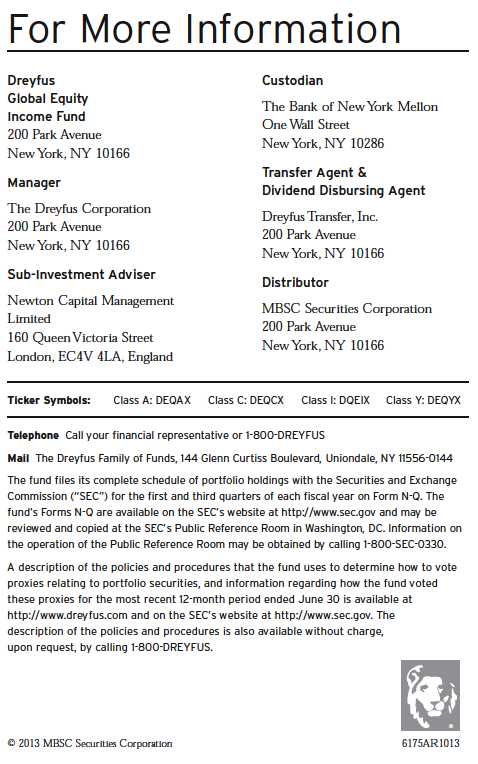UNITED STATES
SECURITIES AND EXCHANGE COMMISSION
Washington, D.C. 20549
FORM N-CSR
CERTIFIED SHAREHOLDER REPORT OF REGISTERED MANAGEMENT
INVESTMENT COMPANIES
Investment Company Act file number | 811- 00524 |
| |
| The Dreyfus/Laurel Funds Trust | |
| (Exact name of Registrant as specified in charter) | |
| | |
| c/o The Dreyfus Corporation 200 Park Avenue New York, New York 10166 | |
| (Address of principal executive offices) (Zip code) | |
| | |
| John Pak, Esq. 200 Park Avenue New York, New York 10166 | |
| (Name and address of agent for service) | |
|
Registrant's telephone number, including area code: | (212) 922-6000 |
| |
Date of fiscal year end: | 10/31 | |
Date of reporting period: | 10/31/2013 | |
| | | | | | | |
The following N-CSR relates only to the series of the Registrant listed below, and does not affect the other series of the Registrant, which have different fiscal year ends and, therefore, different N-CSR reporting requirements. Separate N-CSR Forms will be filed for those series, as appropriate.
Dreyfus Global Equity Income Fund
Dreyfus International Bond Fund
FORM N-CSR
Item 1. Reports to Stockholders.

The views expressed in this report reflect those of the portfolio manager only through the end of the period covered and do not necessarily represent the views of Dreyfus or any other person in the Dreyfus organization. Any such views are subject to change at any time based upon market or other conditions and Dreyfus disclaims any responsibility to update such views.These views may not be relied on as investment advice and, because investment decisions for a Dreyfus fund are based on numerous factors, may not be relied on as an indication of trading intent on behalf of any Dreyfus fund.

| | Contents |
| | THE FUND |
| 2 | A Letter from the President |
| 3 | Discussion of Fund Performance |
| 6 | Fund Performance |
| 8 | Understanding Your Fund’s Expenses |
| 8 | Comparing Your Fund’s Expenses With Those of Other Funds |
| 9 | Statement of Investments |
| 13 | Statement of Assets and Liabilities |
| 14 | Statement of Operations |
| 15 | Statement of Changes in Net Assets |
| 17 | Financial Highlights |
| 21 | Notes to Financial Statements |
| 35 | Report of Independent Registered Public Accounting Firm |
| 36 | Important Tax Information |
| 37 | Board Members Information |
| 39 | Officers of the Fund |
| | FOR MORE INFORMATION |
| | Back Cover |
Dreyfus
Global Equity
Income Fund
The Fund
A LETTER FROM THE PRESIDENT
Dear Shareholder:
We are pleased to present this annual report for Dreyfus Global Equity Income Fund, covering the 12-month period from November 1, 2012, through October 31, 2013. For information about how the fund performed during the reporting period, as well as general market perspectives, we provide a Discussion of Fund Performance on the pages that follow.
Improving global economic conditions drove developed stock markets higher over much of the reporting period. Europe appeared to put the worst of its sovereign debt and banking crises behind it, and Japan embarked on a new economic course designed to reflate its long-stagnant domestic economy. However, the world’s emerging markets struggled with the effects of local economic slowdowns. As a result, equity market returns varied widely from one country to another over the past 12 months.
We currently expect global economic conditions to continue to improve in 2014, with stronger growth in many developed countries fueled by past and continuing monetary ease. The emerging markets seem poised for moderate economic expansion despite recently negative investor sentiment. In the United States, we anticipate accelerating growth supported by the fading drags of tighter federal fiscal policies and downsizing on the state and local levels. For more information on how these observations may affect your investments, we encourage you to speak with your financial advisor.
Thank you for your continued confidence and support.
Sincerely,

J. Charles Cardona
President
The Dreyfus Corporation
November 15, 2013
2
DISCUSSION OF FUND PERFORMANCE
For the reporting period of November 1, 2012, through October 31, 2013, as provided by James Harries, Portfolio Manager of Newton Capital Management Limited, Sub-Investment Adviser
Fund and Market Performance Overview
For the 12-month period ended October 31, 2013, Dreyfus Global Equity Income Fund’s Class A shares produced a total return of 16.22%, Class C shares returned 15.31% and Class I shares returned 16.63%.1 In comparison, the fund’s benchmark, the FTSE World Index (the “Index”), produced a total return of 24.97% for the same period.2 The fund’s Class Y shares produced a total return of 8.62% for the period since their inception of July 1, 2013, through October 31, 2013.
Stocks in most developed markets responded positively to aggressively accommodative monetary policies. The fund lagged its benchmark, mainly due to underweighted exposure to the United States and lack of exposure to Japanese equities.
The Fund’s Investment Approach
The fund seeks to generate total return, consisting of capital appreciation and income. To pursue this goal, the fund normally invests at least 80% of its assets in equity securities, aiming to focus on dividend-paying stocks of companies located in emerging as well as developed capital markets, incorporating investments in countries such as the United States, Canada,Australia, Hong Kong and Europe.The fund may invest in the securities of companies of any market capitalization, and it may invest up to 30% of its assets in emerging markets.The fund’s portfolio managers will always purchase stocks that, at the time of purchase, have a yield premium over that of the FTSEWorld Index.
We combine “top-down” analysis of current economic trends and investment themes with “bottom-up” stock selection based on fundamental research. Within markets and sectors deemed to be favorable, we seek attractively priced stocks of companies that we believe have sustainable, long-term competitive advantages.
Easy Money Policies Drove Global Equities Higher
Global equity markets advanced strongly over the reporting period amid aggressively accommodative monetary policies from many of the world’s central banks. Investors responded especially positively to quantitative easing programs involving massive bond purchases. Indeed, there is disagreement with the consensus view that quantitative easing has fueled a sustainable economic recovery in the United States and an end to
The Fund 3
DISCUSSION OF FUND PERFORMANCE (continued)
recession in Europe. Japan also embarked on its own aggressive quantitative easing program in an attempt to reverse its 20-year economic malaise. These developments benefited U.S. and Japanese stock markets most, and investors turned their attention away from dividend-paying stocks to the stocks of economically sensitive companies.
Global equity markets encountered heightened volatility in late May, when remarks by Federal Reserve Board (the “Fed”) Chairman Ben Bernanke were widely interpreted as a signal that U.S. monetary policymakers would soon begin to back away from their quantitative easing program. However, with the exception of the emerging markets, most global equity markets stabilized over the summer and rallied in September when the Fed refrained from tapering its asset purchases. Conversely, emerging-markets stocks fared relatively poorly due to concerns that slowing growth in China and reduced monetary support in the United States might undermine export activity.
Preference for Less Cyclical Sectors Dampened Performance
The fund produced double-digit returns during the reporting period, but it lagged the Index due to a lack of exposure to Japanese stocks and an underweighted position in U.S. equities, and was disadvantaged by a preference for exposure to companies and industries which are less sensitive to overall market movements.
The market backdrop of the past twelve months as a whole favored riskier stocks of companies in cyclical industry groups. Consequently, investors flocked to the financials, consumer services and industrials sectors, all areas of underweighted exposure for the fund. Instead, the fund had overweight exposures in less market-sensitive industries, such as consumer goods, telecommunications, and utilities industries, which lagged market averages. An overweight allocation to the health care sector was, however, beneficial over the reporting period.
In terms of negative performance over the review period, the holding in South African mining company Gold Fields was the greatest detractor, having struggled against a falling gold price and challenges relating to costs and operations, which resulted in a cut in the company’s dividend, and consequent sale of the position from the fund. Elsewhere, tobacco company Phillip Morris International was also disadvantageous, on account of weakness in its emerging-market operating environments. Telekom Polska also featured among prominent detractors, following radical changes in its domestic industry environment, which lead to cuts in its dividend, and sale of the entire holding from the fund. Among U.S. holdings, Annaly Capital Management was negatively impacted by the decline in U.S. Treasuries over the summer, prompted by fears of “tapering” by the Fed. In the UK, electric utilities company SSE suffered against a fractious political backdrop for energy companies.
4
Positive performance was led by German industrial transportation company Deutsche Post, which benefited from continued growth of DHL serving the world’s online retail businesses. The fund’s void position in technology leader Apple was advantageous in relative terms, as the stock declined on account of poor trading and disappointing innovation over the year.The fund’s holding in competitor Microsoft was one of the most prominent areas of positive performance. In the health care sector, where the fund has an overweight position, the holding in Roche Holding was particularly beneficial, supported by positive pipeline developments. Elsewhere, the position in U.S. defense company Lockheed Martin was beneficial after fears of cuts in defense spending failed to materialize.
Maintaining a Cautious Investment Posture
We remain skeptical of the market’s consensus view that quantitative easing has produced a sustainable global economic recovery. Rather, we expect further instability as quantitative easing support is withdrawn, as recently evidenced by a spike in U.S. mortgage rates in the wake of the Fed’s tapering announcement. In our view, quantitative easing risks the inflation of asset bubbles, and distortion of asset valuations. Consequently, we have maintained the fund’s focus on stocks whose business models are less economically sensitive, more durable, and focused on structural rather than cyclical growth. As of the reporting period’s end, we have identified a number of opportunities in the consumer goods, health care, and telecommunications sectors, but relatively few in the financials, basic materials, and consumer services sectors.
November 15, 2013
|
| Please note, the position in any security highlighted with italicized typeface was sold during the reporting period. |
| Equity funds are subject generally to market, market sector, market liquidity, issuer and investment style risks, among |
| other factors, to varying degrees, all of which are more fully described in the fund’s prospectus. |
| The fund’s performance will be influenced by political, social and economic factors affecting investments in foreign |
| companies. Special risks associated with investments in foreign companies include exposure to currency fluctuations, less |
| liquidity, less developed or less efficient trading markets, lack of comprehensive company information, political |
| instability and differing auditing and legal standards.These risks generally are greater with emerging market countries |
| than with more economically and politically established foreign countries. |
| 1 Total return includes reinvestment of dividends and any capital gains paid, and does not take into consideration the |
| maximum initial sales charge in the case of Class A shares, or the applicable contingent deferred sales charge imposed |
| on redemptions in the case of Class C shares. Had these charges been reflected, returns would have been lower. Past |
| performance is no guarantee of future results. Share price and investment return fluctuate such that upon redemption, |
| fund shares may be worth more or less than their original cost. |
| 2 SOURCE: LIPPER INC. – Reflects reinvestment of dividends and, where applicable, capital gain distributions.The |
| FTSE World Index is an unmanaged, free-floating, market-capitalization weighted index that is designed to measure |
| the performance of 90% of the world’s investable stocks issued by large and midcap companies in developed and |
| advanced emerging markets. Investors cannot invest directly in any index. |
The Fund 5
FUND PERFORMANCE
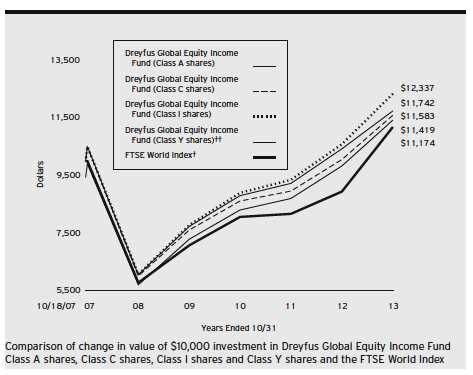
| |
| † | Source: Lipper Inc. |
| †† | The total return figures presented for ClassY shares of the fund reflect the performance of the fund’s Class A shares |
| | for the period prior to 7/1/13 (the inception date for ClassY shares). |
| Past performance is not predictive of future performance. |
| The above graph compares a $10,000 investment made in each of the Class A, Class C, Class I and ClassY shares of |
| Dreyfus Global Equity Income Fund on 10/18/07 (the fund’s inception date) to a $10,000 investment made in the |
| FTSE World Index (the “Index”) on that date.All dividends and capital gain distributions are reinvested. |
| On April 24, 2013, the Board authorized the fund to offer ClassY shares, as a new class of shares, to certain investors, |
| including certain institutional investors. On July 1, 2013, ClassY shares were offered at net asset value and are not |
| subject to certain fees, including Distribution Plan and Shareholder Services Plan fees. |
| The fund’s performance shown in the line graph above takes into account the maximum initial sales charge on Class A |
| shares and all other applicable fees and expenses on all classes.The Index is a widely accepted, unmanaged, free-float |
| market capitalization-weighted index that is designed to measure the performance of 90% of the world’s investable stocks |
| issued by large and mid-cap companies in developed and advanced emerging markets. Unlike a mutual fund, the Index is |
| not subject to charges, fees and other expenses. Investors cannot invest directly in any index. Further information relating |
| to fund performance, including expense reimbursements, if applicable, is contained in the Financial Highlights section of |
| the prospectus and elsewhere in this report. |
6
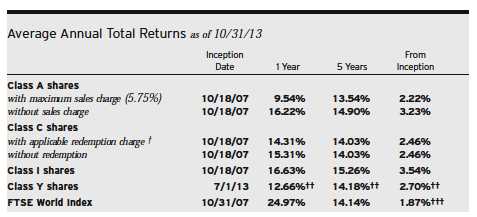
| |
| Past performance is not predictive of future performance.The fund’s performance shown in the graph and table does not |
| reflect the deduction of taxes that a shareholder would pay on fund distributions or the redemption of fund shares. |
| † | The maximum contingent deferred sales charge for Class C shares is 1% for shares redeemed within one year of the |
| | date of purchase. |
| †† | The total return performance figures presented for ClassY shares of the fund reflect the performance of the fund’s |
| | Class A shares for the period prior to 7/1/13 (the inception date for ClassY shares). |
| ††† | For comparative purposes, the value of the Index as of 10/31/07 is used as the beginning value on 10/18/07. |
The Fund 7
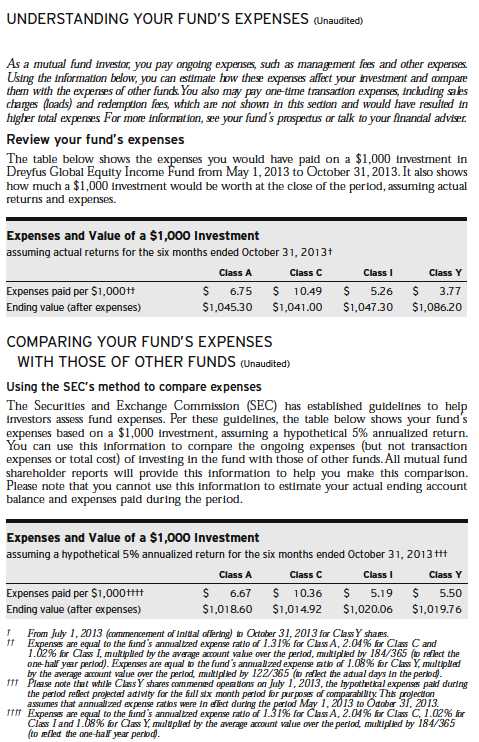
8
STATEMENT OF INVESTMENTS
October 31, 2013
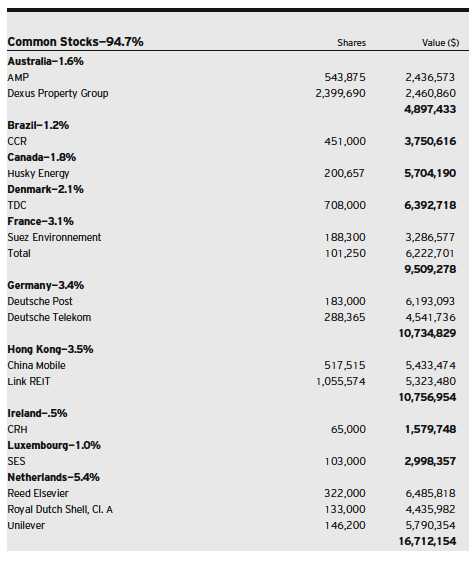
The Fund 9
STATEMENT OF INVESTMENTS (continued)
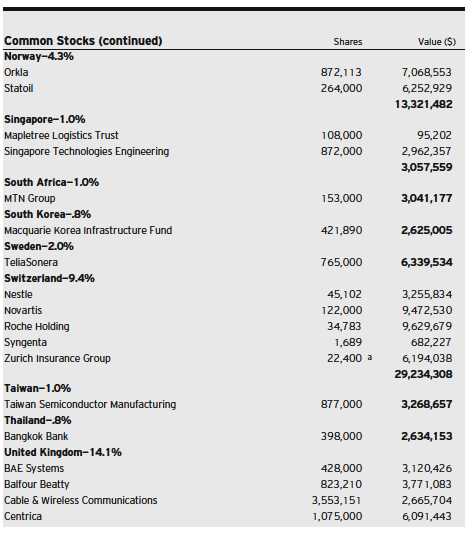
10

The Fund 11
STATEMENT OF INVESTMENTS (continued)

| |
| REIT—Real Estate Investment Trust |
| a | Non-income producing security. |
| b | Investment in real estate investment trust. |
| c | Investment in affiliated money market mutual fund. |

|
| † Based on net assets. |
| See notes to financial statements. |
12
STATEMENT OF ASSETS AND LIABILITIES
October 31, 2013

|
| See notes to financial statements. |
The Fund 13
STATEMENT OF OPERATIONS
Year Ended October 31, 2013
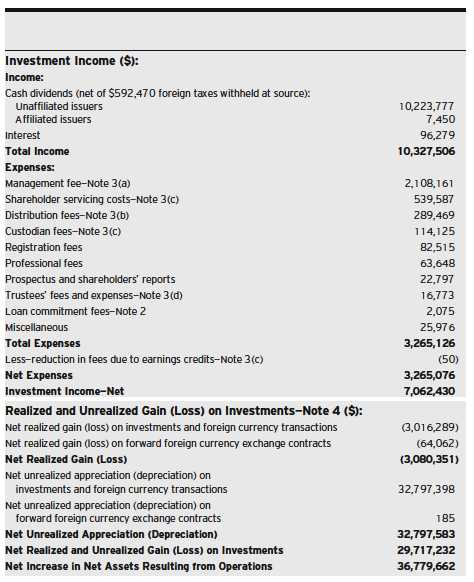
|
| See notes to financial statements. |
14
STATEMENT OF CHANGES IN NET ASSETS
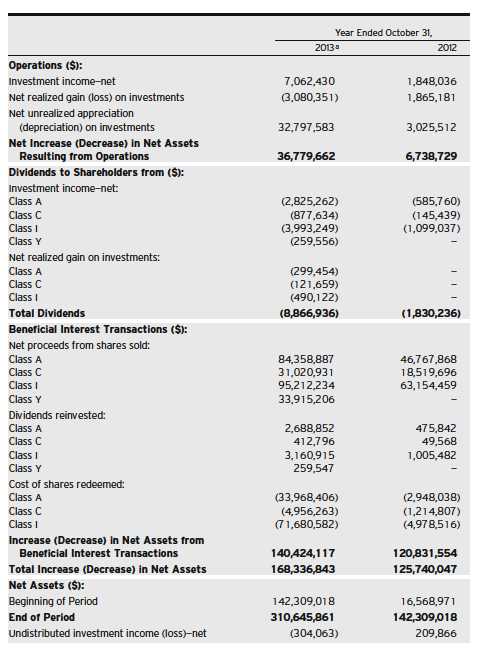
The Fund 15
STATEMENT OF CHANGES IN NET ASSETS (continued)
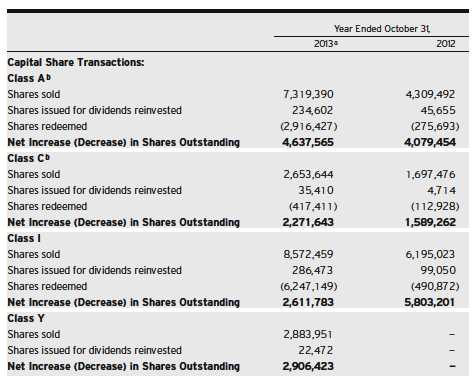
| |
| a | Effective July 1, 2013, the fund commenced offering ClassY shares. |
| b | During the period ended October 31, 2013, 245 Class C shares representing $3,028 were exchanged for 249 |
| | Class A shares. |
| See notes to financial statements. |
16
FINANCIAL HIGHLIGHTS
The following tables describe the performance for each share class for the fiscal periods indicated.All information (except portfolio turnover rate) reflects financial results for a single fund share.Total return shows how much your investment in the fund would have increased (or decreased) during each period, assuming you had reinvested all dividends and distributions.These figures have been derived from the fund’s financial statements.
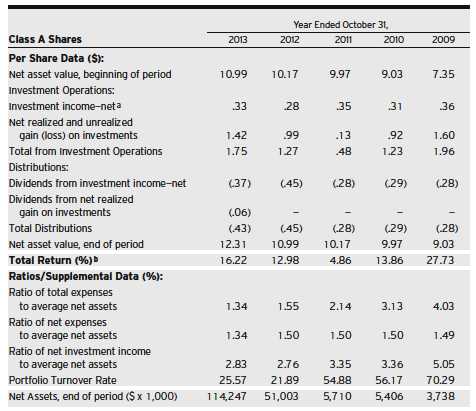
| |
| a | Based on average shares outstanding at each month end. |
| b | Exclusive of sales charge. |
| See notes to financial statements. |
The Fund 17
FINANCIAL HIGHLIGHTS (continued)
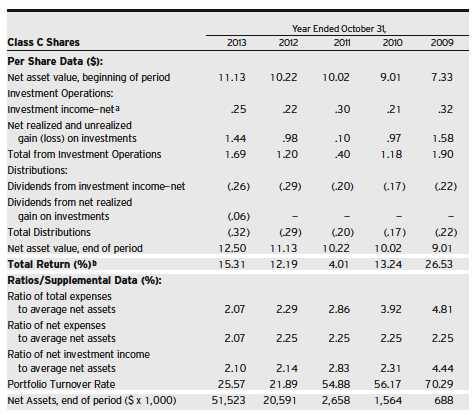
| |
| a | Based on average shares outstanding at each month end. |
| b | Exclusive of sales charge. |
| See notes to financial statements. |
18
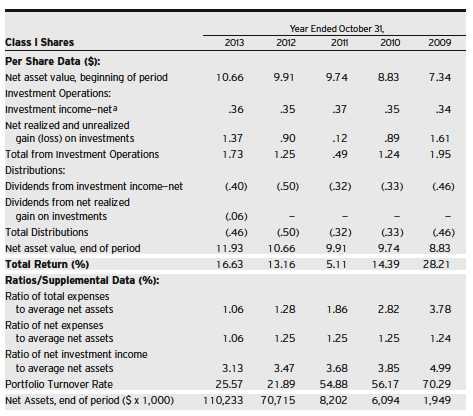
|
| a Based on average shares outstanding at each month end. |
| See notes to financial statements. |
The Fund 19
FINANCIAL HIGHLIGHTS (continued)
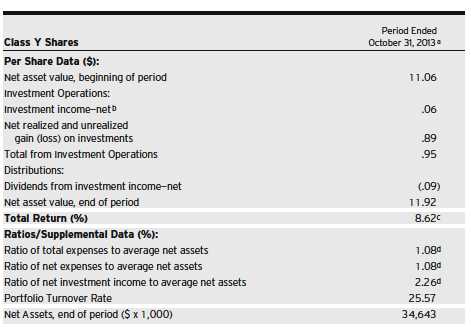
| |
| a | From July 1, 2013 (commencement of initial offering) to October 31, 2013. |
| b | Based on average shares outstanding at each month end. |
| c | Not annualized. |
| d | Annualized. |
| See notes to financial statements. |
20
NOTES TO FINANCIAL STATEMENTS
NOTE 1—Significant Accounting Policies:
Dreyfus Global Equity Income Fund (the “fund”) is a separate diversified series of The Dreyfus/Laurel Funds Trust (the “Trust”), which is registered under the Investment Company Act of 1940, as amended (the “Act”), as an open-end management investment company and operates as a series company currently offering five series, including the fund.The fund’s investment objective is to seek total return (consisting of capital appreciation and income).The Dreyfus Corporation (the “Manager” or “Dreyfus”), a wholly-owned subsidiary of The Bank of New York Mellon Corporation (“BNY Mellon”), serves as the fund’s investment adviser. Newton Capital Management Limited (“Newton”), an affiliate of BNY Mellon, serves as the fund’s sub-investment adviser.
At a meeting held on April 24-25, 2013, the Trust’s Board of Trustees (the “Board”) approved, effective July 1, 2013, for the fund to offer Class Y shares.
MBSC Securities Corporation (the “Distributor”), a wholly-owned subsidiary of Dreyfus, is the distributor of the fund’s shares.The fund is authorized to issue an unlimited number of $.001 par value shares of Beneficial Interest in each of the following classes of shares: Class A, Class C, Class I and ClassY. Class A and Class C shares are sold primarily to retail investors through financial intermediaries and bear Distribution and/or Shareholder Services Plan fees. Class A shares generally are subject to a sales charge imposed at the time of purchase. Class C shares are subject to a contingent deferred sales charge (“CDSC”) imposed on Class C shares redeemed within one year of purchase. Class I shares are sold primarily to bank trust departments and other financial service providers (including The Bank of NewYork Mellon, a subsidiary of BNY Mellon and an affiliate of Dreyfus, and its affiliates), acting on behalf of customers having a qualified trust or an investment account or relationship at such institution, and bear no Distribution or Shareholder Services Plan fees. Class I shares are offered without a front-end sales charge or CDSC. Class Y shares are
The Fund 21
NOTES TO FINANCIAL STATEMENTS (continued)
sold at net asset value per share to certain investors, including certain institutional investors. Other differences between the classes include the services offered to and the expenses borne by each class, the allocation of certain transfer agency costs and certain voting rights. Income, expenses (other than expenses attributable to a specific class), and realized and unrealized gains or losses on investments are allocated to each class of shares based on its relative net assets.
As of October 31, 2013, MBC Investments Corp., an indirect subsidiary of BNY Mellon, held all of the outstanding ClassY shares of the fund.
The Trust accounts separately for the assets, liabilities and operations of each series. Expenses directly attributable to each series are charged to that series’ operations; expenses which are applicable to all series are allocated among them on a pro rata basis.
The Financial Accounting Standards Board (“FASB”) Accounting Standards Codification is the exclusive reference of authoritative U.S. generally accepted accounting principles (“GAAP”) recognized by the FASB to be applied by nongovernmental entities. Rules and interpretive releases of the Securities and Exchange Commission (“SEC”) under authority of federal laws are also sources of authoritative GAAP for SEC registrants. The fund’s financial statements are prepared in accordance with GAAP, which may require the use of management estimates and assumptions.Actual results could differ from those estimates.
(a) Portfolio valuation: The fair value of a financial instrument is the amount that would be received to sell an asset or paid to transfer a liability in an orderly transaction between market participants at the measurement date (i.e., the exit price). GAAP establishes a fair value hierarchy that prioritizes the inputs of valuation techniques used to measure fair value. This hierarchy gives the highest priority to unadjusted quoted prices in active markets for identical assets or liabilities (Level 1 measurements) and the lowest priority to unobservable inputs (Level 3 measurements).
22
Additionally, GAAP provides guidance on determining whether the volume and activity in a market has decreased significantly and whether such a decrease in activity results in transactions that are not orderly. GAAP requires enhanced disclosures around valuation inputs and techniques used during annual and interim periods.
Various inputs are used in determining the value of the fund’s investments relating to fair value measurements.These inputs are summarized in the three broad levels listed below:
Level 1—unadjusted quoted prices in active markets for identical investments.
Level 2—other significant observable inputs (including quoted prices for similar investments, interest rates, prepayment speeds, credit risk, etc.).
Level 3—significant unobservable inputs (including the fund’s own assumptions in determining the fair value of investments).
The inputs or methodology used for valuing securities are not necessarily an indication of the risk associated with investing in those securities.
Changes in valuation techniques may result in transfers in or out of an assigned level within the disclosure hierarchy.Valuation techniques used to value the fund’s investments are as follows:
Investments in equity securities are valued at the last sales price on the securities exchange or national securities market on which such securities are primarily traded. Securities listed on the National Market System for which market quotations are available are valued at the official closing price or, if there is no official closing price that day, at the last sales price. Securities not listed on an exchange or the national securities market, or securities for which there were no transactions, are valued at the average of the most recent bid and asked prices, except for open short positions, where the asked price is used for valuation purposes. Bid price is used when no asked price is available. Registered investment
The Fund 23
NOTES TO FINANCIAL STATEMENTS (continued)
companies that are not traded on an exchange are valued at their net asset value.All of the preceding securities are categorized within Level 1 of the fair value hierarchy.
Investments in debt securities excluding short-term investments (other than U.S.Treasury Bills) and forward foreign currency exchange contracts (“forward contracts”) are valued each business day by an independent pricing service (the “Service”) approved by the Board. Investments for which quoted bid prices are readily available and are representative of the bid side of the market in the judgment of the Service are valued at the mean between the quoted bid prices (as obtained by the Service from dealers in such securities) and asked prices (as calculated by the Service based upon its evaluation of the market for such securities). Other investments are valued as determined by the Service, based on methods which include consideration of the following: yields or prices of securities of comparable quality, coupon, maturity and type; indications as to values from dealers; and general market conditions.These securities are generally categorized within Level 2 of the fair value hierarchy.
The Service’s procedures are reviewed by Dreyfus under the general supervision of the Board.
Fair valuing of securities may be determined with the assistance of a pricing service using calculations based on indices of domestic securities and other appropriate indicators, such as prices of relevant American Depository Receipts and financial futures. Utilizing these techniques may result in transfers between Level 1 and Level 2 of the fair value hierarchy.
When market quotations or official closing prices are not readily available, or are determined not to reflect accurately fair value, such as when the value of a security has been significantly affected by events after the close of the exchange or market on which the security is principally traded (for example, a foreign exchange or market), but before the fund calculates its net asset value, the fund may value these investments at fair value as determined in accordance with the proce-
24
dures approved by the Board. Certain factors may be considered when fair valuing investments such as: fundamental analytical data, the nature and duration of restrictions on disposition, an evaluation of the forces that influence the market in which the securities are purchased and sold, and public trading in similar securities of the issuer or comparable issuers. These securities are either categorized within Level 2 or 3 of the fair value hierarchy depending on the relevant inputs used.
For restricted securities where observable inputs are limited, assumptions about market activity and risk are used and are categorized within Level 3 of the fair value hierarchy.
Investments denominated in foreign currencies are translated to U.S. dollars at the prevailing rates of exchange.
Forward contracts are valued at the forward rate and are generally categorized within Level 2 of the fair value hierarchy.
The following is a summary of the inputs used as of October 31, 2013 in valuing the fund’s investments:
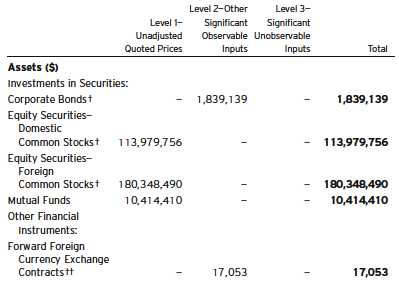
The Fund 25
NOTES TO FINANCIAL STATEMENTS (continued)
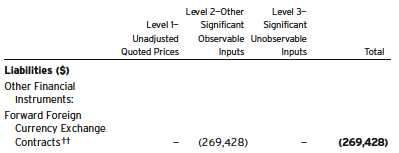
| |
| † | See Statement of Investments for additional detailed categorizations. |
| †† | Amount shown represents unrealized appreciation (depreciation) at period end. |
At October 31, 2013, there were no transfers between Level 1 and Level 2 of the fair value hierarchy.
(b) Foreign currency transactions: The fund does not isolate that portion of the results of operations resulting from changes in foreign exchange rates on investments from the fluctuations arising from changes in market prices of securities held. Such fluctuations are included with the net realized and unrealized gain or loss on investments.
Net realized foreign exchange gains or losses arise from sales of foreign currencies, currency gains or losses realized on securities transactions between trade and settlement date, and the difference between the amounts of dividends, interest and foreign withholding taxes recorded on the fund’s books and the U.S. dollar equivalent of the amounts actually received or paid. Net unrealized foreign exchange gains and losses arise from changes in the value of assets and liabilities other than investments resulting from changes in exchange rates. Foreign currency gains and losses on foreign currency transactions are also included with net realized and unrealized gain or loss on investments.
(c) Securities transactions and investment income: Securities transactions are recorded on a trade date basis. Realized gains and losses from securities transactions are recorded on the identified cost basis. Dividend income is recognized on the ex-dividend date and interest income, including, where applicable, accretion of discount and amortization of premium on investments, is recognized on the accrual basis.
26
(d) Affiliated issuers: Investments in other investment companies advised by Dreyfus are defined as “affiliated” under the Act. Investments in affiliated investment companies during the period ended October 31, 2013 were as follows:

(e) Risk: Investing in foreign markets may involve special risks and considerations not typically associated with investing in the U.S.These risks include revaluation of currencies, high rates of inflation, repatriation restrictions on income and capital, and adverse political and economic developments. Moreover, securities issued in these markets may be less liquid, subject to government ownership controls and delayed settlements, and their prices may be more volatile than those of comparable securities in the U.S.
(f) Dividends to shareholders: Dividends are recorded on the ex-dividend date. Dividends from investment income-net are declared and paid quarterly. Dividends from net realized capital gains, if any, are normally declared and paid annually, but the fund may make distributions on a more frequent basis to comply with the distribution requirements of the Internal Revenue Code of 1986, as amended (the “Code”).To the extent that net realized capital gains can be offset by capital loss carryovers, it is the policy of the fund not to distribute such gains. Income and capital gain distributions are determined in accordance with income tax regulations, which may differ from GAAP.
(g) Federal income taxes: It is the policy of the fund to continue to qualify as a regulated investment company, if such qualification is in the best interests of its shareholders, by complying with the applicable pro-
The Fund 27
NOTES TO FINANCIAL STATEMENTS (continued)
visions of the Code, and to make distributions of taxable income sufficient to relieve it from substantially all federal income and excise taxes.
As of and during the period ended October 31, 2013, the fund did not have any liabilities for any uncertain tax positions.The fund recognizes interest and penalties, if any, related to uncertain tax positions as income tax expense in the Statement of Operations. During the period ended October 31, 2013, the fund did not incur any interest or penalties.
Each tax year in the four-year period ended October 31, 2013 remains subject to examination by the Internal Revenue Service and state taxing authorities.
At October 31, 2013, the components of accumulated earnings on tax basis were as follows: undistributed ordinary income $310,699, accumulated capital losses $3,242,143 and unrealized appreciation $35,547,038.
Under the Regulated Investment Company Modernization Act of 2010 (the “2010 Act”), the fund is permitted to carry forward capital losses incurred in taxable years beginning after December 22, 2010 (“post-enactment losses”) for an unlimited period. Furthermore, post-enactment capital loss carryovers retain their character as either short-term or long-term capital losses rather than short-term as they were under previous statute.
The accumulated capital loss carryover is available for federal income tax purposes to be applied against future net realized capital gains, if any, realized subsequent to October 31, 2013.The fund has $2,347,083 of post-enactment short-term capital losses and $895,060 of post-enactment long-term capital losses which can be carried forward for an unlimited period.
The tax character of distributions paid to shareholders during the fiscal periods ended October 31, 2013 and October 31, 2012 were as follows: ordinary income $8,226,563 and $1,830,236, and long-term capital gains $640,373 and $0, respectively.
28
During the period ended October 31, 2013 as a result of permanent book to tax differences, primarily due to the tax treatment for foreign currency gains and losses, passive foreign investment companies, real estate investment trusts, dividend reclassification and amortization of premiums, the fund increased accumulated undistributed investment income-net by $379,342 and decreased accumulated net realized gain (loss) on investments by the same amount. Net assets and net asset value per share were not affected by this reclassification.
(h) Accounting Pronouncement: In January 2013, FASB issued Accounting Standards Update No. 2013-01 (“ASU 2013-01”), “Clarifying the Scope of Disclosures about Offsetting Assets and Liabilities”, which replaced Accounting Standards Update No. 2011-11 (“ASU 2011-11”), “Disclosures about Offsetting Assets and Liabilities”. ASU 2013-01 is effective for fiscal years beginning on or after January 1, 2013, and interim periods within those annual periods.ASU 2011-11 was intended to enhance disclosure requirements on the offsetting of financial assets and liabilities.ASU 2013-01 limits the scope of the new balance sheet offsetting disclosures to derivatives, repurchase agreements, and securities lending transactions to the extent that they are (1) offset in the financial statements or (2) subject to enforceable master netting arrangements (“MNA”) or similar agreements. Management is currently evaluating the application of ASU 2013-01 and its impact on the fund’s financial statements.
NOTE 2—Bank Lines of Credit:
The fund participates with other Dreyfus-managed funds in a $265 million unsecured credit facility led by Citibank, N.A. and a $300 million unsecured credit facility provided by The Bank of New York Mellon (each, a “Facility”), each to be utilized primarily for temporary or emergency purposes, including the financing of redemptions. Prior to October 9, 2013, the unsecured credit facility with Citibank, N.A.
The Fund 29
NOTES TO FINANCIAL STATEMENTS (continued)
was $210 million. In connection therewith, the fund has agreed to pay its pro rata portion of commitment fees for each Facility. Interest is charged to the fund based on rates determined pursuant to the terms of the respective Facility at the time of borrowing. During the period ended October 31, 2013, the fund did not borrow under the Facilities.
NOTE 3—Management Fee, Sub-Investment Advisory Fee and Other Transactions with Affiliates:
(a) Pursuant to a management agreement with Dreyfus and the Trust, the Trust has agreed to pay Dreyfus a management fee computed at the annual rate of .85% of the value of the fund’s average daily net assets and is payable monthly.
Dreyfus had contractually agreed, from November 1, 2012 through February 28, 2013, to waive receipt of its fees and/or assume the expenses of the fund so that the expenses of none of the classes (excluding Rule 12b-1 Distribution Plan fees, Shareholder Services Plan fees, taxes, interest expense, brokerage commissions, commitment fees on borrowings and extraordinary expenses) exceeded 1.25% of the value of the fund’s average daily net assets.Thereafter, Dreyfus has contractually agreed from March 1, 2013 through July 1, 2014, to waive receipt of its fees and/or assume the expenses of the fund so that the expenses of none of the classes (excluding certain expenses as described above) exceed 1.10% of the value of the fund’s average daily net assets. During the period ended October 31, 2013, there was no reduction in expenses.
Pursuant to a Sub-Investment Advisory Agreement between Dreyfus and Newton, Dreyfus pays Newton an annual fee of .41% of the value of the fund’s average daily net assets.
During the period ended October 31, 2013, the Distributor retained $105,018 from commissions earned on sales of the fund’s Class A shares and $26,530 from CDSCs on redemptions of the fund’s Class C shares.
(b) Under the Distribution Plan adopted pursuant to Rule 12b-1 under the Act, Class C shares pay the Distributor for distributing its shares at an annual rate of .75% of the value of its average daily net
30
assets. During the period ended October 31, 2013, Class C shares were charged $289,469, pursuant to the Distribution Plan.
(c) Under the Shareholder Services Plan, Class A and Class C shares pay the Distributor at an annual rate of .25% of the value of their average daily net assets for the provision of certain services.The services provided may include personal services relating to shareholder accounts, such as answering shareholder inquiries regarding the fund and providing reports and other information, and services related to the maintenance of shareholder accounts.The Distributor may make payments to Service Agents (securities dealers, financial institutions or other industry professionals) with respect to these services. The Distributor determines the amounts to be paid to Service Agents. During the period ended October 31, 2013, Class A and Class C shares were charged $225,664 and $96,490, respectively, pursuant to the Shareholder Services Plan.
Under its terms, the Distribution Plan and Shareholder Services Plan shall remain in effect from year to year, provided such continuance is approved annually by a vote of a majority of those Trustees who are not “interested persons” of the Trust and who have no direct or indirect financial interest in the operation of or in any agreement related to the Distribution Plan or Shareholder Services Plan.
The fund has arrangements with the transfer agent and the custodian whereby the fund may receive earnings credits when positive cash balances are maintained, which are used to offset transfer agency and custody fees. For financial reporting purposes, the fund includes net earnings credits as an expense offset in the Statement of Operations.
The fund compensates DreyfusTransfer, Inc., a wholly-owned subsidiary of Dreyfus, under a transfer agency agreement for providing transfer agency and cash management services for the fund. The majority of transfer agency fees are comprised of amounts paid on a per account basis, while cash management fees are related to fund subscriptions and redemptions. During the period ended October 31, 2013, the fund was
The Fund 31
NOTES TO FINANCIAL STATEMENTS (continued)
charged $9,774 for transfer agency services and $371 for cash management services.These fees are included in Shareholder servicing costs in the Statement of Operations. Cash management fees were partially offset by earnings credits of $50.
The fund compensates The Bank of NewYork Mellon under a custody agreement for providing custodial services for the fund.These fees are determined based on net assets, geographic region and transaction activity. During the period ended October 31, 2013, the fund was charged $114,125 pursuant to the custody agreement.
The fund compensated The Bank of New York Mellon under a cash management agreement that was in effect until September 30, 2013 for performing certain cash management services related to fund subscriptions and redemptions. During the period ended October 31, 2013, the fund was charged $177 pursuant to the cash management agreement, which is included in Shareholder servicing costs in the Statement of Operations.
During the period ended October 31, 2013, the fund was charged $8,887 for services performed by the Chief Compliance Officer and his staff.
The components of “Due to The Dreyfus Corporation and affiliates” in the Statement of Assets and Liabilities consist of: management fees $218,110, Distribution Plan fees $32,204, Shareholder Services Plan fees $34,498, custodian fees $26,686, Chief Compliance Officer fees $7,445 and transfer agency fees $9,312.
(d) Each Board member also serves as a Board member of other funds within the Dreyfus complex. Annual retainer fees and attendance fees are allocated to each fund based on net assets.
NOTE 4—Securities Transactions:
The aggregate amount of purchases and sales of investment securities, excluding short term securities and forward contracts, during the period ended October 31, 2013, amounted to $195,353,838 and $59,952,930, respectively.
32
Derivatives: A derivative is a financial instrument whose performance is derived from the performance of another asset. Each type of derivative instrument that was held by the fund during the period ended October 31, 2013 is discussed below.
Forward Foreign Currency Exchange Contracts: The fund enters into forward contracts in order to hedge its exposure to changes in foreign currency exchange rates on its foreign portfolio holdings, to settle foreign currency transactions or as a part of its investment strategy. When executing forward contracts, the fund is obligated to buy or sell a foreign currency at a specified rate on a certain date in the future. With respect to sales of forward contracts, the fund incurs a loss if the value of the contract increases between the date the forward contract is opened and the date the forward contract is closed.The fund realizes a gain if the value of the contract decreases between those dates.With respect to purchases of forward contracts, the fund incurs a loss if the value of the contract decreases between the date the forward contract is opened and the date the forward contract is closed.The fund realizes a gain if the value of the contract increases between those dates. Any realized or unrealized gains or losses which occurred during the period are reflected in the Statement of Operations. The fund is exposed to foreign currency risk as a result of changes in value of underlying financial instruments.The fund is also exposed to credit risk associated with counterparty nonperformance on these forward contracts, which is generally limited to the unrealized gain on each open contract.The following summarizes open forward contracts at October 31, 2013:

The Fund 33
NOTES TO FINANCIAL STATEMENTS (continued)
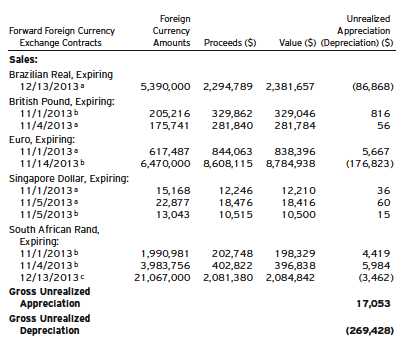
| |
| Counterparties: |
| a | UBS |
| b | Royal Bank of Scotland |
| c | JP Morgan Chase Bank |
The following summarizes the average market value of derivatives outstanding during the period ended October 31, 2013:

At October 31, 2013, the cost of investments for federal income tax purposes was $271,034,107, accordingly, accumulated net unrealized appreciation on investments was $35,547,688, consisting of $39,197,807 gross unrealized appreciation and $3,650,119 gross unrealized depreciation.
34
REPORT OF INDEPENDENT REGISTERED
PUBLIC ACCOUNTING FIRM
The Board of Trustees and Shareholders of
The Dreyfus/Laurel Funds Trust
We have audited the accompanying statement of assets and liabilities of Dreyfus Global Equity Income Fund (the “Fund”), a series of The Dreyfus/Laurel FundsTrust, including the statement of investments, as of October 31, 2013, and the related statement of operations for the year then ended, the statements of changes in net assets for each of the years in the two-year period then ended, and the financial highlights for each of the years or period in the five-year period then ended.These financial statements and financial highlights are the responsibility of the Fund’s management. Our responsibility is to express an opinion on these financial statements and financial highlights based on our audits.
We conducted our audits in accordance with the standards of the Public Company Accounting Oversight Board (United States).Those standards require that we plan and perform the audit to obtain reasonable assurance about whether the financial statements and financial highlights are free of material misstatement. An audit includes examining, on a test basis, evidence supporting the amounts and disclosures in the financial statements. Our procedures included confirmation of securities owned as of October 31, 2013, by correspondence with the custodian and brokers or by other appropriate auditing procedures. An audit also includes assessing the accounting principles used and significant estimates made by management, as well as evaluating the overall financial statement presentation.We believe that our audits provide a reasonable basis for our opinion.
In our opinion, the financial statements and financial highlights referred to above present fairly, in all material respects, the financial position of Dreyfus Global Equity Income Fund as of October 31, 2013, the results of its operations for the year then ended, the changes in its net assets for each of the years in the two-year period then ended, and the financial highlights for each of the years or period in the five-year period then ended, in conformity with U.S. generally accepted accounting principles.

New York, New York
December 30, 2013
The Fund 35
IMPORTANT TAX INFORMATION (Unaudited)
For federal tax purposes, the fund elects to provide each shareholder with their portion of the fund’s income sourced from foreign countries and taxes paid from foreign countries. The fund reports the maximum amount allowable but not less than $6,944,247 as income sourced from foreign countries for the fiscal year ended October 31, 2013 in accordance with Section 853(c)(2) of the Internal Revenue Code and also the fund reports the maximum amount allowable but not less than $571,155 as taxes paid from foreign countries for the fiscal year ended October 31, 2013 in accordance with Section 853(a) of the Internal Revenue Code. Where required by federal tax law rules, shareholders will receive notification of their proportionate share of foreign sourced income and foreign taxes paid for the 2013 calendar year with Form 1099-DIV which will be mailed in early 2014. Also, the fund designates the maximum amount allowable, but not less than $7,676,067 as ordinary income dividends paid during the fiscal year ended October 31, 2013 as qualified dividend income in accordance with Section 854(b)(1)(B) of the Internal Revenue Code. Also, the fund reports the maximum amount allowable but not less than $.0400 per share as a capital gain dividend in accordance with Section 852(b)(3)(C) of the Internal Revenue Code.Also, the fund reports the maximum amount allowable but not less than $.0165 as a short-term capital gain dividend paid on December 18, 2012 in accordance with Sections 871(k)(2) and 881(e) of the Internal Revenue Code.
36
BOARD MEMBERS INFORMATION (Unaudited)
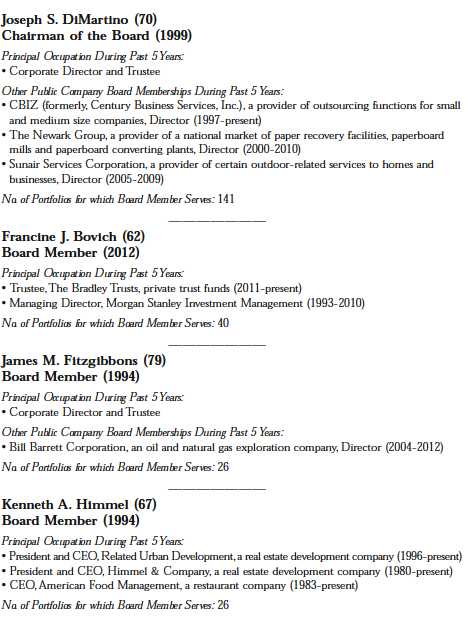
The Fund 37
BOARD MEMBERS INFORMATION (Unaudited) (continued)

38
OFFICERS OF THE FUND (Unaudited)
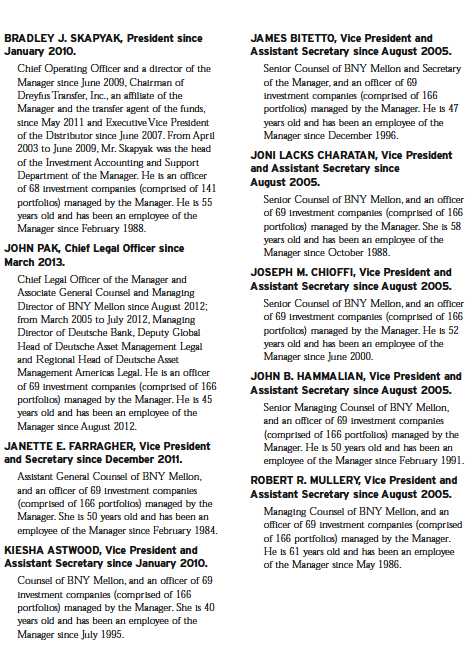
The Fund 39
OFFICERS OF THE FUND (Unaudited) (continued)
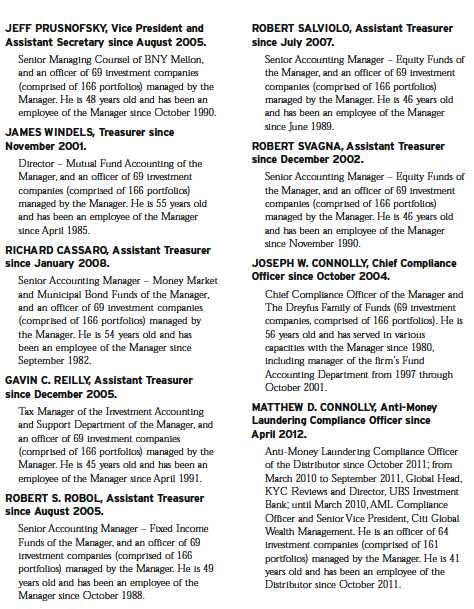
40

The views expressed in this report reflect those of the portfolio manager only through the end of the period covered and do not necessarily represent the views of Dreyfus or any other person in the Dreyfus organization. Any such views are subject to change at any time based upon market or other conditions and Dreyfus disclaims any responsibility to update such views.These views may not be relied on as investment advice and, because investment decisions for a Dreyfus fund are based on numerous factors, may not be relied on as an indication of trading intent on behalf of any Dreyfus fund.

| | Contents |
| | THE FUND |
| 2 | A Letter from the President |
| 3 | Discussion of Fund Performance |
| 6 | Fund Performance |
| 8 | Understanding Your Fund’s Expenses |
| 8 | Comparing Your Fund’s Expenses With Those of Other Funds |
| 9 | Statement of Investments |
| 25 | Statement of Financial Futures |
| 26 | Statement of Assets and Liabilities |
| 27 | Statement of Operations |
| 28 | Statement of Changes in Net Assets |
| 30 | Financial Highlights |
| 34 | Notes to Financial Statements |
| 58 | Report of Independent Registered Public Accounting Firm |
| 59 | Important Tax Information |
| 60 | Board Members Information |
| 62 | Officers of the Fund |
| | FOR MORE INFORMATION |
| | Back Cover |
Dreyfus
International Bond Fund
The Fund
A LETTER FROM THE PRESIDENT
Dear Shareholder:
We are pleased to present this annual report for Dreyfus International Bond Fund, covering the 12-month period from November 1, 2012, through October 31, 2013. For information about how the fund performed during the reporting period, as well as general market perspectives, we provide a Discussion of Fund Performance on the pages that follow.
The reporting period proved to be a challenging time for fixed-income securities throughout the world. A gradually strengthening global economy, led by the United States and Japan, drove longer term interest rates higher and bond prices lower in most developed markets. Corporate-backed bonds generally held up better than their sovereign counterparts as default rates remained low and issuers’ business prospects improved along with the economy. In contrast, emerging-markets bonds were particularly hard hit when investors withdrew investment capital from developing nations in favor of industrialized economies. International fixed-income returns for U.S. residents also were hurt by a stronger U.S. dollar relative to other major currencies.
We currently expect U.S. and global economic conditions to continue to improve in 2014, with accelerating growth supported by the fading drags of tighter federal fiscal policies and downsizing on the state and local levels. Moreover, inflation is likely to remain muted, so monetary policy can remain stimulative. Globally, we anticipate stronger growth in developed countries due to past and continuing monetary ease, while emerging markets seem poised for moderate economic expansion despite recently negative investor sentiment. For more information on how these observations may affect your investments, we encourage you to speak with your financial advisor.
Thank you for your continued confidence and support.
Sincerely,

J. Charles Cardona
President
The Dreyfus Corporation
November 15, 2013
2
DISCUSSION OF FUND PERFORMANCE
For the period of November 1, 2012, through October 31, 2013, as provided by David Leduc, CFA, and Brendan Murphy, CFA, Portfolio Managers
Fund and Market Performance Overview
For the 12-month period ended October 31, 2013, Dreyfus International Bond Fund’s Class A shares produced a total return of –2.14%, Class C shares returned –2.78%, Class I shares returned –1.78%, and ClassY shares returned 2.43%.1 In comparison, the fund’s benchmark, the Barclays Global Aggregate ex-U.S. (Unhedged) Bond Index (the “Index”), produced a total return of –1.95% for the same period.2
Global bond markets proved volatile during the reporting period when stronger economic growth sent long-term interest rates higher in many markets.The fund’s Class I shares produced higher returns than the benchmark, mainly due to overweighted exposure to European and U.S. corporate-backed bonds.
The Fund’s Investment Approach
The fund seeks to maximize total return through capital appreciation and income.To pursue its goal, the fund normally invests at least 80% of its net assets in fixed-income securities, and at least 65% of its assets in non-U.S. dollar-denominated fixed-income securities of foreign governments and companies located in various countries, including emerging markets.
Generally, the fund seeks to maintain investment-grade average credit quality. We focus on identifying undervalued government bond markets, currencies, sectors, and securities. We look for fixed-income securities with the most potential for added value, such as those involving the potential for credit upgrades, unique structural characteristics, or innovative features. We use fundamental economic research and quantitative analysis to allocate assets among countries and currencies.We then focus on sectors and individual securities that appear to be relatively undervalued.
Rising Long-Term Rates Roiled Global Bond Markets
The reporting period began amid heightened market volatility as investors responded nervously to improving economic conditions. Employment gains, rebounding housing markets, and a massive quantitative easing program enabled the United States to lead the global recovery. The worst of Europe’s financial crisis seems to be over, as
The Fund 3
DISCUSSION OF FUND PERFORMANCE (continued)
evidenced by stronger economic data and rebounding bond prices in previously hard hit nations. Japan’s economic outlook was lifted by stimulative fiscal and monetary policies from a new government seeking an end to years of economic stagnation. These factors generally helped drive bond yields higher, and prices lower, in the United States and Europe, while Japanese sovereign bonds gained a degree of value. Most emerging markets struggled with economic slowdowns, resulting in outflows of investment capital and falling bond prices.
The global bond markets’ worries about rising interest rates intensified in late May, when remarks by Federal Reserve Board (the “Fed”) Chairman Ben Bernanke were interpreted as a signal that the central bank would back away from its quantitative easing program sooner than expected. Consequently, most bond markets fell sharply in June before stabilizing over the summer. Global bonds rallied in September and October when the Fed refrained from tapering its ongoing quantitative easing program.
Returns from global bonds for U.S. residents were also undermined by a strengthening U.S. dollar, especially relative to the Japanese yen and emerging-markets currencies. The U.S. dollar advanced more moderately against the euro.
Corporate Bonds Supported Fund Performance
Although the fund was affected negatively by the challenging fixed-income investment environment, its results compared to the benchmark were bolstered by an emphasis on corporate-backed bonds, which fared relatively well when business conditions improved.The fund achieved particularly strong results from investment-grade and high yield corporate securities in Europe and, to a lesser degree, the United States. Our currency strategies also added value to the fund’s performance, as underweighted exposure to the yen cushioned the brunt of the Japanese currency’s weakness.
On the other hand, a short average duration in Japan limited the fund’s participation in one of the world’s stronger bond markets. Overweighted exposure to inflation-protected sovereign bonds in Sweden and Denmark also weighed on the fund’s relative results.
Finding Value in Global Bond Markets
We have been encouraged by recent evidence that the global economic recovery is gaining traction, but we are aware that higher interest rates often accompany more robust economic conditions. Indeed, we have already seen signs of more moderately

accommodative monetary policies in the United States and United Kingdom.While Europe recently posted modestly positive growth, we believe that low inflation will enable the European Central Bank to maintain easy money policies over the foreseeable future.
Therefore, we have retained the fund’s emphasis on corporate bonds and other market sectors that tend to be less sensitive to changing interest rates, and we have set the fund’s average duration in the United States and Japan in positions that are shorter than local market averages.We also have found a number of attractively valued opportunities in the emerging markets, prompting us to increase the fund’s exposure to sovereign bonds from developing countries. Our currency strategy has maintained an overweighted position in the U.S. dollar relative to most other currencies, especially the Japanese yen.
November 15, 2013
|
| Bond funds are subject generally to interest rate, credit, liquidity and market risks, to varying degrees, all of which are |
| more fully described in the fund’s prospectus. Generally, all other factors being equal, bond prices are inversely related |
| to interest-rate changes, and rate increases can cause price declines. |
| High yield bonds are subject to increased credit risk and are considered speculative in terms of the issuer’s perceived |
| ability to continue making interest payments on a timely basis and to repay principal upon maturity. |
| Foreign bonds are subject to special risks including exposure to currency fluctuations, changing political and economic |
| conditions, and potentially less liquidity.These risks are generally greater with emerging market countries than with |
| more economically and politically established foreign countries. |
| The use of derivatives involves risks different from, or possibly greater than, the risks associated with investing directly |
| in the underlying assets. Derivatives can be highly volatile, illiquid and difficult to value, and there is the risk that |
| changes in the value of a derivate held by the fund will not correlate with the underlying instruments or the fund’s |
| other instruments. |
| Investments in foreign currencies are subject to the risk that those currencies will decline in value relative to the U.S. |
| dollar, or, in the case of hedged positions, that the U.S. dollar will decline relative to the currency being hedged. |
| Currency rates in foreign countries may fluctuate significantly over short periods of time.A decline in the value of |
| foreign currencies relative to the U.S. dollar will reduce the value of securities held by the fund and denominated in |
| those currencies.The use of leverage may magnify the fund’s gains or losses. For derivatives with a leveraging |
| component, adverse changes in the value or level of the underlying asset can result in a loss that is much greater than |
| the original investment in the derivative. |
| 1 Total return includes reinvestment of dividends and any capital gains paid and does not take into consideration the |
| maximum initial sales charge in the case of Class A shares or the applicable contingent deferred sales charge imposed |
| on redemptions in the case of Class C shares. Had these charges been reflected, returns would have been lower. Class I |
| and ClassY shares are not subject to any initial or deferred sales charge. Past performance is no guarantee of future |
| results. Share price and investment return fluctuate such that upon redemption, fund shares may be worth more or less |
| than their original cost. ClassY shares returns are as of inception 7/1/13. |
| 2 SOURCE: LIPPER — Reflects reinvestment of dividends and, where applicable, capital gain distributions.The |
| Barclays Global Aggregate ex-U.S. (Unhedged) Bond Index provides a broad-based measure of the global investment- |
| grade fixed income markets. Investors cannot invest directly in any index. |
The Fund 5
FUND PERFORMANCE
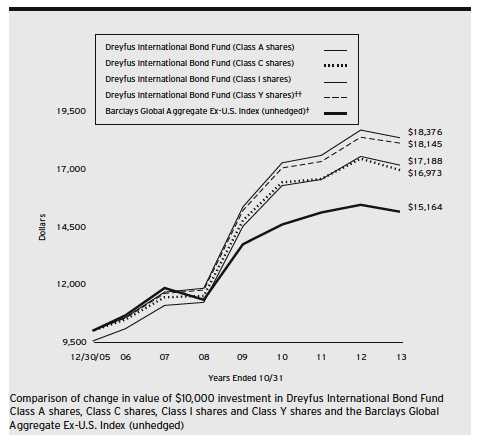
| |
| † | Source: Lipper Inc. |
| †† | The total return figures presented for ClassY shares of the fund reflect the performance of the fund’s Class A shares |
| | for the period prior to 7/1/13 (the inception date for ClassY shares). |
| Past performance is not predictive of future performance. |
| The above graph compares a $10,000 investment made in each of the Class A, Class C, Class I and ClassY shares of |
| Dreyfus International Bond Fund on 12/30/05 (the fund’s inception date) to a $10,000 investment made in the |
| Barclays Global Aggregate Ex-U.S. Index (unhedged) (the “Index”) on that date.All dividends and capital gain |
| distributions are reinvested. |
| On April 24, 2013, the Board authorized the fund to offer ClassY shares, as a new class of shares, to certain investors, |
| including certain institutional investors. On July 1, 2013, ClassY shares were offered at net asset value and are not |
| subject to certain fees, including Distribution Plan and Shareholder Services Plan fees. |
| The fund invests 80% of its assets primarily in fixed-income securities.The fund’s performance shown in the line graph |
| above takes into account the maximum initial sales charge on Class A shares and all other applicable fees and expenses on |
| all classes.The Index is designed to measure the performance of global investment-grade, fixed-rate debt markets, excluding |
| the United States, hedged into U.S. dollars. Unlike a mutual fund, the Index is not subject to charges, fees and other |
| expenses. Investors cannot invest directly in any index. Further information relating to fund performance, including expense |
| reimbursements, if applicable, is contained in the Financial Highlights section of the prospectus and elsewhere in this report. |
6
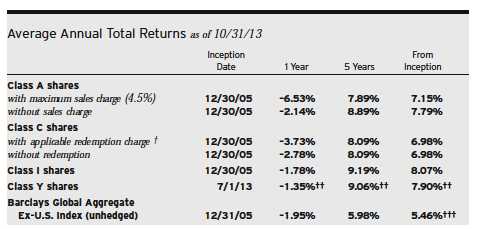
| |
| Past performance is not predictive of future performance.The fund’s performance shown in the graph and table does not |
| reflect the deduction of taxes that a shareholder would pay on the fund distributions or the redemption of fund shares. |
| † | The maximum contingent deferred sales charge for Class C shares is 1% for shares redeemed within one year of the |
| | date of purchase. |
| †† | The total return performance figures presented for ClassY shares of the fund reflect the performance of the fund’s |
| | Class A shares for the period prior to 7/1/13 (the inception date for ClassY shares). |
| ††† | For comparative purposes, the value of the Index as of 12/31/05 is used as the beginning value on 12/30/05. |
The Fund 7

8
STATEMENT OF INVESTMENTS
October 31, 2013
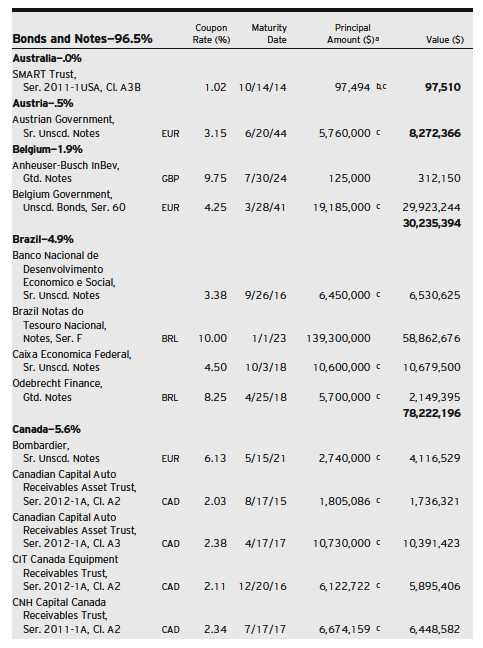
The Fund 9
STATEMENT OF INVESTMENTS (continued)
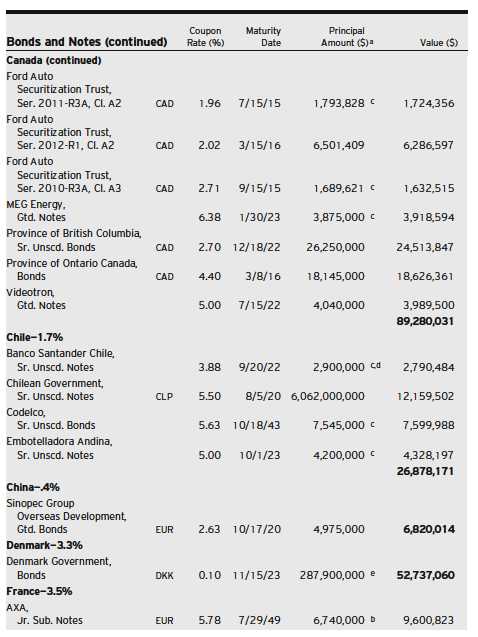
10

The Fund 11
STATEMENT OF INVESTMENTS (continued)
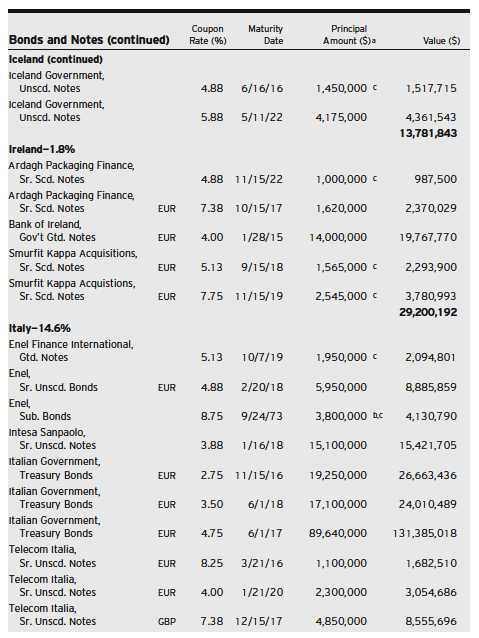
12
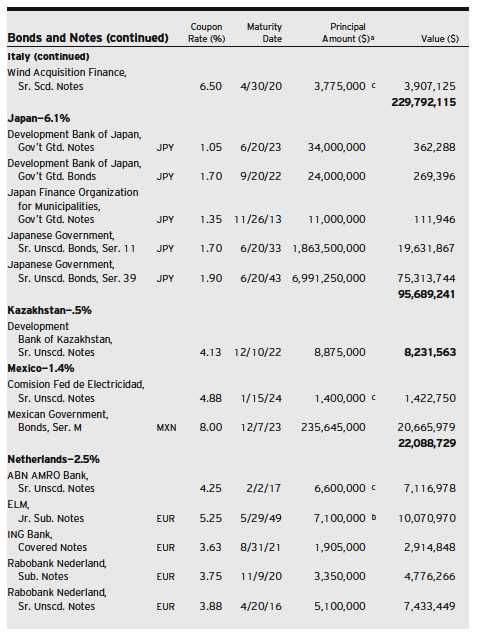
The Fund 13
STATEMENT OF INVESTMENTS (continued)
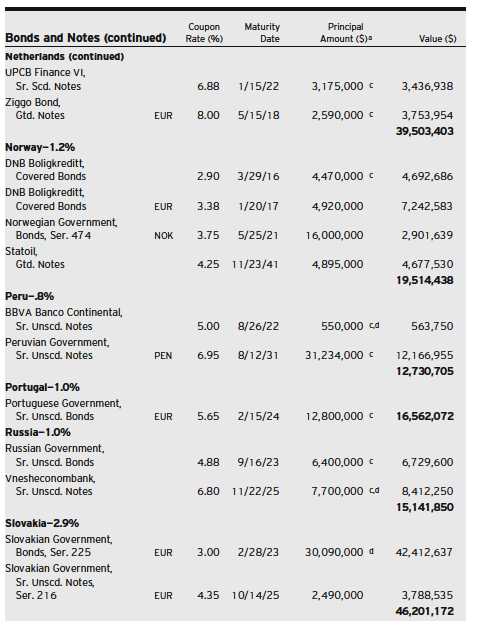
14

The Fund 15
STATEMENT OF INVESTMENTS (continued)

16
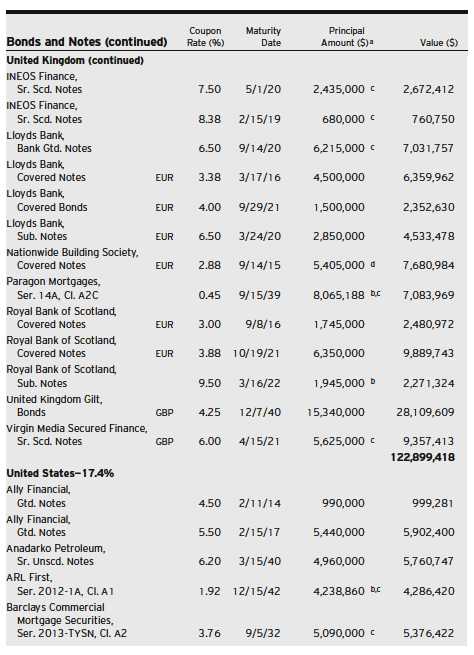
The Fund 17
STATEMENT OF INVESTMENTS (continued)
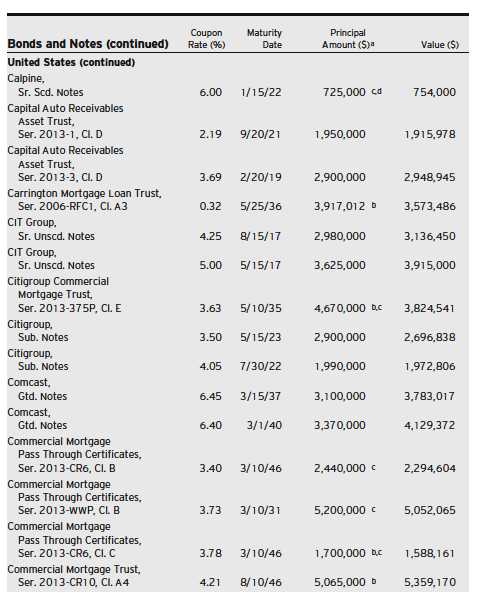
18
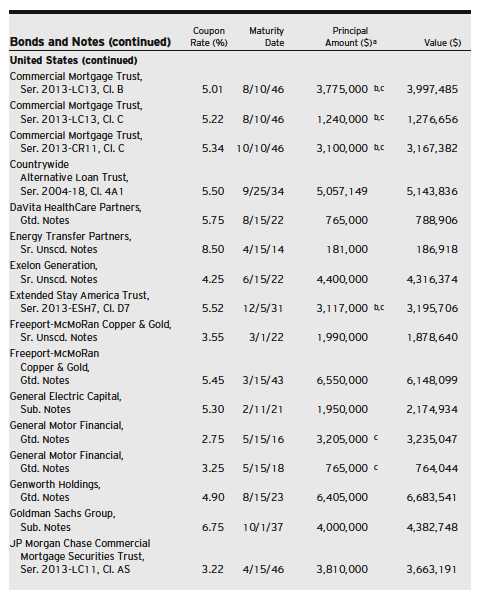
The Fund 19
STATEMENT OF INVESTMENTS (continued)
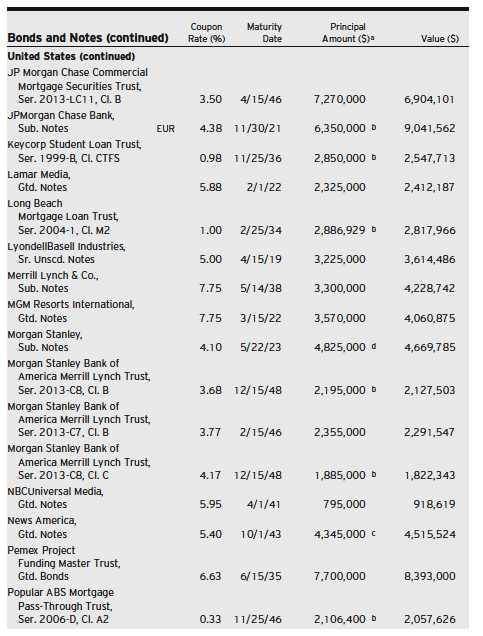
20

The Fund 21
STATEMENT OF INVESTMENTS (continued)
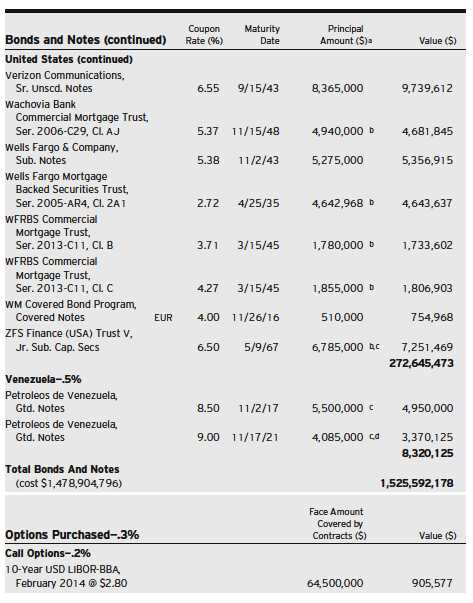
22
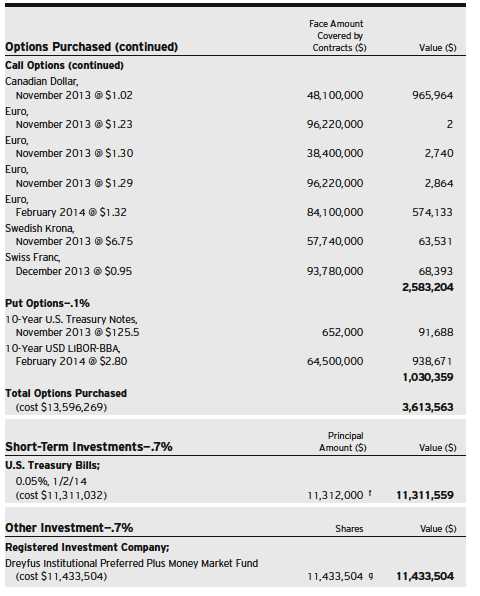
The Fund 23
STATEMENT OF INVESTMENTS (continued)
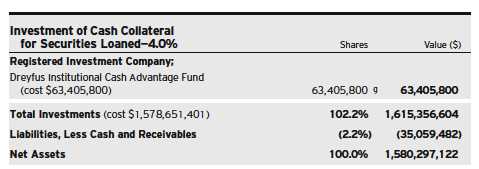
|
| BBA—British Bankers Association |
| LIBOR—London Interbank Offered Rate |
| USD—U.S. Dollar |
| a Principal amount stated in U.S. Dollars unless otherwise noted. |
| AUD—Australian Dollar |
| BRL—Brazilian Real |
| CAD—Canadian Dollar |
| CLP—Chilean Peso |
| CNY—ChineseYuan Renminbi |
| DKK—Danish Krone |
| EUR—Euro |
| GBP—British Pound |
| JPY—JapaneseYen |
| NOK—Norwegian Krone |
| PEN—Peruvian New Sol |
| b Variable rate security—interest rate subject to periodic change. |
| c Securities exempt from registration pursuant to Rule 144A under the Securities Act of 1933.These securities may be |
| resold in transactions exempt from registration, normally to qualified institutional buyers.At October 31, 2013, these |
| securities were valued at $401,681,669 or 25.4% of net assets. |
| d Security, or portion thereof, on loan.At October 31, 2013, the value ofe funds securities on loan was $65,170,729 |
| and the value of the collateral held by the fund was $69,049,898, consisting of cash collateral of $63,405,800 and |
| U.S. Government & Agency securities valued at $5,644,098. |
| e Principal amount for accrual purposes is periodically adjusted based on changes in the Danish Consumer Price Index. |
| f Held by or on behalf of a counterparty for open financial futures contracts. |
| g Investment in affiliated money market mutual fund. |

|
| † Based on net assets. |
| See notes to financial statements. |
24
STATEMENT OF FINANCIAL FUTURES
October 31, 2013
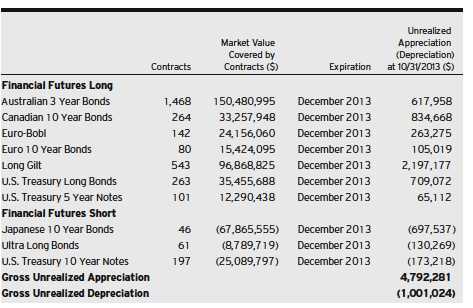
|
| See notes to financial statements. |
The Fund 25
STATEMENT OF ASSETS AND LIABILITIES
October 31, 2013
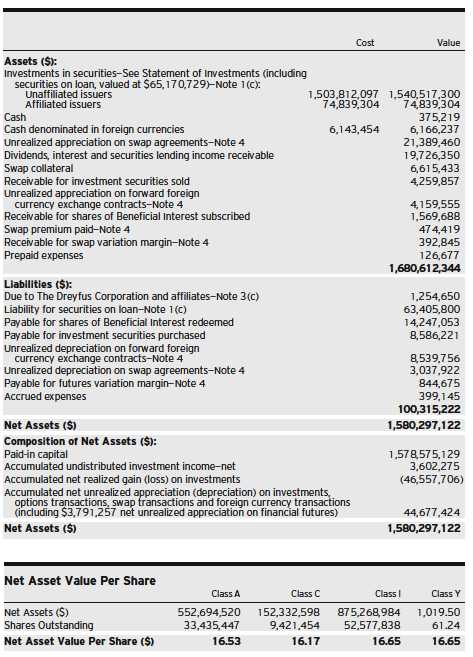
|
| See notes to financial statements. |
26
STATEMENT OF OPERATIONS
Year Ended October 31, 2013

|
| See notes to financial statements. |
The Fund 27
STATEMENT OF CHANGES IN NET ASSETS
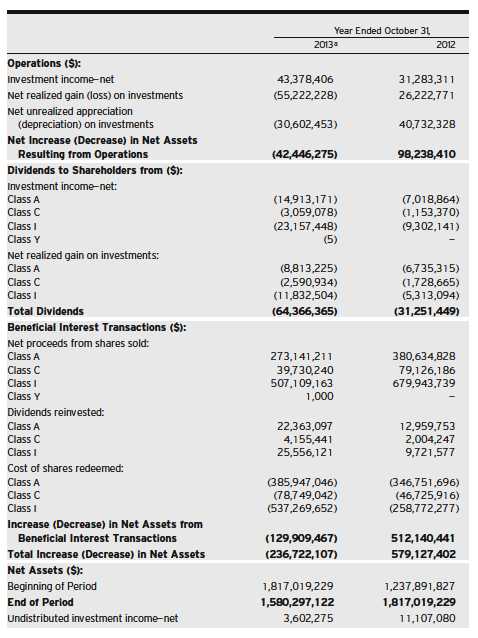
28
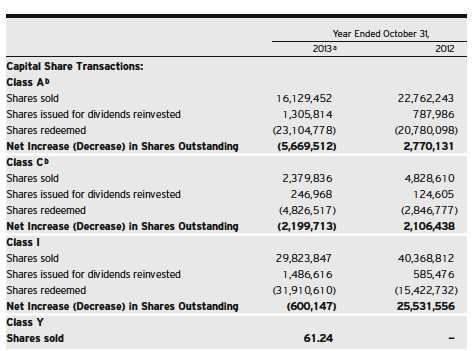
| |
| a | Effective July 1, 2013, the fund commenced offering ClassY shares. |
| b | During the period ended October 31, 2013, 45,481 Class C shares representing $744,979 were exchanged for |
| | 44,556 Class A shares. |
| See notes to financial statements. |
The Fund 29
FINANCIAL HIGHLIGHTS
The following tables describe the performance for each share class for the fiscal periods indicated. All information (except portfolio turnover rate) reflects financial results for a single fund share.Total return shows how much your investment in the fund would have increased (or decreased) during each period, assuming you had reinvested all dividends and distributions.These figures have been derived from the fund’s financial statements.
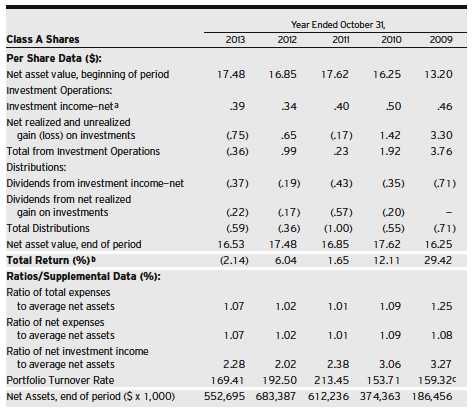
| |
| a | Based on average shares outstanding at each month end. |
| b | Exclusive of sales charge. |
| c | The portfolio turnover rate excluding mortgage dollar roll transactions for the period ended October 31, 2009 |
| | was 144.34%. |
| See notes to financial statements. |
30
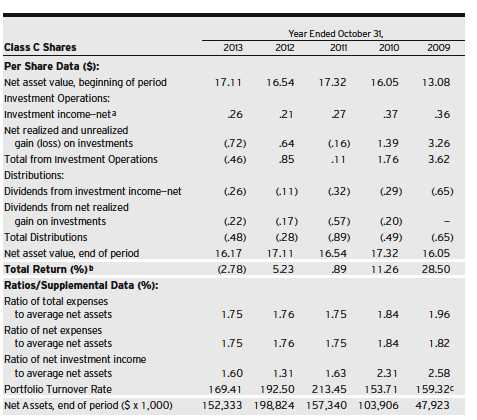
| |
| a | Based on average shares outstanding at each month end. |
| b | Exclusive of sales charge. |
| c | The portfolio turnover rate excluding mortgage dollar roll transactions for the period ended October 31, 2009 |
| | was 144.34%. |
| See notes to financial statements. |
The Fund 31
FINANCIAL HIGHLIGHTS (continued)
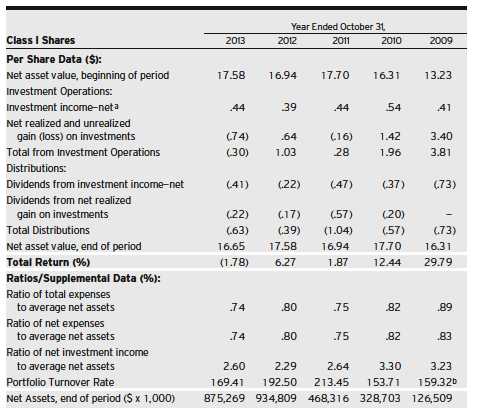
| |
| a | Based on average shares outstanding at each month end. |
| b | The portfolio turnover rate excluding mortgage dollar roll transactions for the period ended October 31, 2009 |
| | was 144.34%. |
| See notes to financial statements. |
32
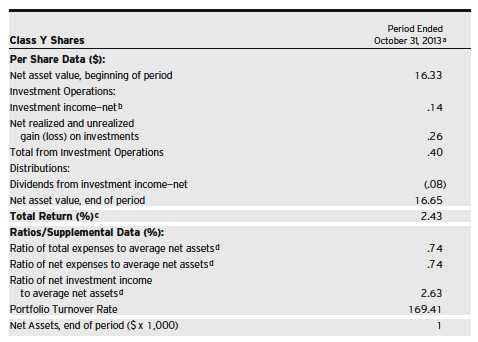
| |
| a | From July 1, 2013 (commencement of initial offering) to October 31, 2013. |
| b | Based on average shares outstanding at each month end. |
| c | Not annualized. |
| d | Annualized. |
| See notes to financial statements. |
The Fund 33
NOTES TO FINANCIAL STATEMENTS
NOTE 1—Significant Accounting Policies:
Dreyfus International Bond Fund (the “fund”) is a separate non-diversified series of The Dreyfus/Laurel Funds Trust (the “Trust”), which is registered under the Investment Company Act of 1940, as amended (the “Act”), as an open-end management investment company and operates as a series company currently offering five series, including the fund. The fund’s investment objective seeks to maximize total return through capital appreciation and income.The Dreyfus Corporation (the “Manager” or “Dreyfus”), a wholly-owned subsidiary of The Bank of New York Mellon Corporation (“BNY Mellon”), serves as the fund’s investment adviser.
At a meeting held on April 24-25, 2013, the Trust’s Board of Trustees (the “Board”) approved, effective July 1, 2013 for the fund to offer Class Y shares.
MBSC Securities Corporation (the “Distributor”), a wholly-owned subsidiary of the Manager, is the distributor of the fund’s shares. The fund is authorized to issue an unlimited number of $.001 par value shares of Beneficial Interest in each of the following classes of shares: Class A, Class C, Class I and ClassY. Class A and Class C shares are sold primarily to retail investors through financial intermediaries and bear Distribution and/or Shareholder Services Plan fees. Class A shares generally are subject to a sales charge imposed at the time of purchase. Class C shares are subject to a contingent deferred sales charge (“CDSC”) imposed on Class C shares redeemed within one year of purchase. Class I shares are sold primarily to bank trust departments and other financial service providers (including The Bank of NewYork Mellon, a subsidiary of BNY Mellon and an affiliate of Dreyfus, and its affiliates), acting on behalf of customers having a qualified trust or an investment account or relationship at such institution, and bear no Distribution or Shareholder Services Plan fees. Class I shares are offered without a front-end sales charge or CDSC. Class Y shares are sold at net asset value per share to certain investors, including certain

institutional investors. Other differences between the classes include the services offered to and the expenses borne by each class, the allocation of certain transfer agency costs and certain voting rights. Income, expenses (other than expenses attributable to a specific class), and realized and unrealized gains or losses on investments are allocated to each class of shares based on its relative net assets.
As of October 31, 2013, MBC Investments Corp., an indirect subsidiary of BNY Mellon, held all of the outstanding ClassY shares of the fund.
The Trust accounts separately for the assets, liabilities and operations of each series. Expenses directly attributable to each series are charged to that series’ operations; expenses which are applicable to all series are allocated among them on a pro rata basis.
The Financial Accounting Standards Board (“FASB”) Accounting Standards Codification is the exclusive reference of authoritative U.S. generally accepted accounting principles (“GAAP”) recognized by the FASB to be applied by nongovernmental entities. Rules and interpretive releases of the Securities and Exchange Commission (“SEC”) under authority of federal laws are also sources of authoritative GAAP for SEC registrants. The fund’s financial statements are prepared in accordance with GAAP, which may require the use of management estimates and assumptions.Actual results could differ from those estimates.
(a) Portfolio valuation: The fair value of a financial instrument is the amount that would be received to sell an asset or paid to transfer a liability in an orderly transaction between market participants at the measurement date (i.e., the exit price). GAAP establishes a fair value hierarchy that prioritizes the inputs of valuation techniques used to measure fair value. This hierarchy gives the highest priority to unadjusted quoted prices in active markets for identical assets or liabilities (Level 1 measurements) and the lowest priority to unobservable inputs (Level 3 measurements).
The Fund 35
NOTES TO FINANCIAL STATEMENTS (continued)
Additionally, GAAP provides guidance on determining whether the volume and activity in a market has decreased significantly and whether such a decrease in activity results in transactions that are not orderly. GAAP requires enhanced disclosures around valuation inputs and techniques used during annual and interim periods.
Various inputs are used in determining the value of the fund’s investments relating to fair value measurements.These inputs are summarized in the three broad levels listed below:
Level 1—unadjusted quoted prices in active markets for identical investments.
Level 2—other significant observable inputs (including quoted prices for similar investments, interest rates, prepayment speeds, credit risk, etc.).
Level 3—significant unobservable inputs (including the fund’s own assumptions in determining the fair value of investments).
The inputs or methodology used for valuing securities are not necessarily an indication of the risk associated with investing in those securities.
Changes in valuation techniques may result in transfers in or out of an assigned level within the disclosure hierarchy. Valuation techniques used to value the fund’s investments are as follows:
Registered investment companies that are not traded on an exchange are valued at their net asset value and are categorized within Level 1 of the fair value hierarchy.
Investments in securities, excluding short-term investments (other than U.S.Treasury Bills), financial futures, options and forward foreign currency exchange contracts (“forward contracts”) are valued each business day by an independent pricing service (the “Service”) approved by the Board. Investments for which quoted bid prices are readily available and are representative of the bid side of the market in the judgment of the Service are valued at the mean between the quoted bid prices (as obtained by the Service from dealers in such securities) and asked prices (as calculated by the Service based upon its
36
evaluation of the market for such securities). Other investments (which constitute a majority of the portfolio securities) are valued as determined by the Service, based on methods which include consideration of the following: yields or prices of securities of comparable quality, coupon, maturity and type; indications as to values from dealers; and general market conditions. These securities are generally categorized within Level 2 of the fair value hierarchy.
U.S. Treasury Bills are valued at the mean price between quoted bid prices and asked prices by the Service. These securities are generally categorized within Level 2 of the fair value hierarchy.
The Service’s procedures are reviewed by Dreyfus under the general supervision of the Board.
When market quotations or official closing prices are not readily available, or are determined not to reflect accurately fair value, such as when the value of a security has been significantly affected by events after the close of the exchange or market on which the security is principally traded (for example, a foreign exchange or market), but before the fund calculates its net asset value, the fund may value these investments at fair value as determined in accordance with the procedures approved by the Board. Certain factors may be considered when fair valuing investments such as: fundamental analytical data, the nature and duration of restrictions on disposition, an evaluation of the forces that influence the market in which the securities are purchased and sold, and public trading in similar securities of the issuer or comparable issuers. These securities are either categorized within Level 2 or 3 of the fair value hierarchy depending on the relevant inputs used.
For restricted securities where observable inputs are limited, assumptions about market activity and risk are used and are categorized within Level 3 of the fair value hierarchy.
Investments denominated in foreign currencies are translated to U.S. dollars at the prevailing rates of exchange.
The Fund 37
NOTES TO FINANCIAL STATEMENTS (continued)
Financial futures and options, which are traded on an exchange, are valued at the last sales price on the securities exchange on which such securities are primarily traded or at the last sales price on the national securities market on each business day and are generally categorized within Level 1 of the fair value hierarchy. Options traded over-the-counter are valued at the mean between the bid and asked price and are generally categorized within Level 2 of the fair value hierarchy. Investments in swap transactions are valued each business day by the Service. Swaps are valued by the Service by using a swap pricing model which incorporates among other factors, default probabilities, recovery rates, credit curves of the underlying issuer and swap spreads on interest rates and are generally categorized within Level 2 of the fair value hierarchy. Forward contracts are valued at the forward rate and are generally categorized within Level 2 of the fair value hierarchy.
The following is a summary of the inputs used as of October 31, 2013 in valuing the fund's investments:
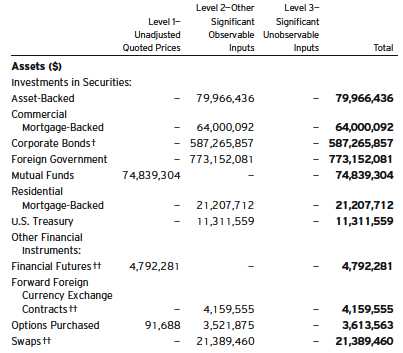
38

| |
| † | See Statement of Investments for additional detailed categorizations. |
| †† | Amount shown represents unrealized appreciation (depreciation) at period end. |
At October 31, 2013, there were no transfers between Level 1 and Level 2 of the fair value hierarchy.
(b) Foreign currency transactions: The fund does not isolate that portion of the results of operations resulting from changes in foreign exchange rates on investments from the fluctuations arising from changes in the market prices of securities held. Such fluctuations are included with the net realized and unrealized gain or loss on investments.
Net realized foreign exchange gains or losses arise from sales of foreign currencies, currency gains or losses realized on securities transactions between trade and settlement date, and the difference between the amounts of dividends, interest and foreign withholding taxes recorded on the fund’s books and the U.S. dollar equivalent of the amounts actually received or paid. Net unrealized foreign exchange gains and losses arise from changes in the value of assets and liabilities other than investments resulting from changes in exchange rates. Foreign currency gains and losses on foreign currency transactions are also included with net realized and unrealized gain or loss on investments.
(c) Securities transactions and investment income: Securities transactions are recorded on a trade date basis. Realized gains and losses from securities transactions are recorded on the identified cost basis. Dividend income is recognized on the ex-dividend date and interest
The Fund 39
NOTES TO FINANCIAL STATEMENTS (continued)
income, including, where applicable, accretion of discount and amortization of premium on investments, is recognized on the accrual basis.
Pursuant to a securities lending agreement with The Bank of New York Mellon, the fund may lend securities to qualified institutions. It is the fund’s policy that, at origination, all loans are secured by collateral of at least 102% of the value of U.S. securities loaned and 105% of the value of foreign securities loaned. Collateral equivalent to at least 100% of the market value of securities on loan is maintained at all times. Collateral is either in the form of cash, which can be invested in certain money market mutual funds managed by the Manager or U.S. Government and Agency securities.The fund is entitled to receive all dividends, interest and distributions on securities loaned, in addition to income earned as a result of the lending transaction. Should a borrower fail to return the securities in a timely manner,The Bank of NewYork Mellon is required to replace the securities for the benefit of the fund or credit the fund with the market value of the unreturned securities and is subrogated to the fund’s rights against the borrower and the collateral. During the period ended October 31, 2013, The Bank of New York Mellon earned $74,852 from lending portfolio securities, pursuant to the securities lending agreement.
(d) Affiliated issuers: Investments in other investment companies advised by Dreyfus are defined as “affiliated” under the Act. Investments in affiliated investment companies during the period ended October 31, 2013 were as follows:
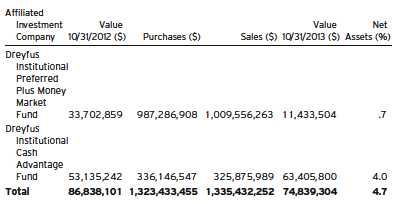
40
(e) Risk: The fund invests primarily in debt securities. Failure of an issuer of the debt securities to make timely interest or principal payments, or a decline or the perception of a decline in the credit quality of a debt security, can cause the debt security’s price to fall, potentially lowering the fund’s share price. In addition, the value of debt securities may decline due to general market conditions that are not specifically related to a particular issuer, such as real or perceived adverse economic conditions, changes in outlook for corporate earnings, changes in interest or currency rates or adverse investor sentiment. They may also decline because of factors that affect a particular industry or country.
Investing in foreign markets may involve special risks and considerations not typically associated with investing in the U.S. These risks include revaluation of currencies, high rates of inflation, repatriation restrictions on income and capital, and adverse political and economic developments. Moreover, securities issued in these markets may be less liquid, subject to government ownership controls and delayed settlements, and their prices may be more volatile than those of comparable securities in the U.S.
(f) Dividends to shareholders: Dividends are recorded on ex-dividend date. Dividends from investment income-net are normally declared and paid quarterly. Dividends from net realized capital gains, if any, are normally declared and paid annually, but the fund may make distributions on a more frequent basis to comply with the distribution requirements of the Internal Revenue Code of 1986, as amended (the “Code”). To the extent that net realized capital gains can be offset by capital loss carryovers, it is the policy of the fund not to distribute such gains. Income and capital gain distributions are determined in accordance with income tax regulations, which may differ from GAAP.
On October 31, 2013, the Board declared a cash dividend of $.039, $.009, $.054 and $.055 per share from undistributed investment income-net for Class A, Class C, Class I and ClassY shares, respectively, payable on November 1, 2013 (ex-dividend date), to shareholders of record as of the close of business on October 31, 2013.
The Fund 41
NOTES TO FINANCIAL STATEMENTS (continued)
(g) Federal income taxes: It is the policy of the fund to continue to qualify as a regulated investment company, if such qualification is in the best interests of its shareholders, by complying with the applicable provisions of the Code, and to make distributions of taxable income sufficient to relieve it from substantially all federal income and excise taxes.
As of and during the period ended October 31, 2013, the fund did not have any liabilities for any uncertain tax positions.The fund recognizes interest and penalties, if any, related to uncertain tax positions as income tax expense in the Statement of Operations. During the period October 31, 2013, the fund did not incur any interest or penalties.
Each tax year in the four-year period ended October 31, 2013 remains subject to examination by the Internal Revenue Service and state taxing authorities.
At October 31, 2013, the components of accumulated earnings on a tax basis were as follows: undistributed ordinary income $6,254,740, accumulated capital losses $54,014,492 and unrealized appreciation $49,481,745.
Under the Regulated Investment Company Modernization Act of 2010 (the “2010 Act”), the fund is permitted to carry forward capital losses incurred in taxable years beginning after December 22, 2010 (“post-enactment losses”) for an unlimited period. Furthermore, post-enactment capital loss carryovers retain their character as either short-term or long-term capital losses rather than short-term as they were under previous statute.
The accumulated capital loss carryover is available for federal income tax purposes to be applied against future net realized capital gains, if any, realized subsequent to October 31, 2013. The fund has $25,206,428 of post-enactment short-term capital losses and $28,808,064 of post-enactment long-term capital losses which can be carried forward for an unlimited period.
The tax character of distributions paid to shareholders during the fiscal periods ended October 31, 2013 and October 31, 2012 were as follows: ordinary income $64,366,365 and $20,347,781, and long-term capital gains $0 and $10,903,668, respectively.
42
During the period ended October 31, 2013, as a result of permanent book to tax differences, primarily due to the tax treatment for paydowns gains and losses, foreign currency transactions, swap periodic payments and dividend reclassification, the fund decreased accumulated undistributed investment income-net by $9,753,509 and increased accumulated net realized gain (loss) on investments by the same amount. Net assets and net asset value per share were not affected by this reclassification.
(h) New Accounting Pronouncement: In January 2013, FASB issued Accounting Standards Update No. 2013-01 (“ASU 2013-01”), “Clarifying the Scope of Disclosures about Offsetting Assets and Liabilities”, which replaced Accounting Standards Update No. 2011-11 (“ASU 2011-11”), “Disclosures about Offsetting Assets and Liabilities”. ASU 2013-01 is effective for fiscal years beginning on or after January 1, 2013, and interim periods within those annual periods.ASU 2011-11 was intended to enhance disclosure requirements on the offsetting of financial assets and liabilities. ASU 2013-01 limits the scope of the new balance sheet offsetting disclosures to derivatives, repurchase agreements, and securities lending transactions to the extent that they are (1) offset in the financial statements or (2) subject to enforceable master netting arrangements (“MNA”) or similar agreements. Management is currently evaluating the application of ASU 2013-01 and its impact on the fund’s financial statements.
NOTE 2—Bank Lines of Credit:
The fund participates with other Dreyfus-managed funds in a $265 million unsecured credit facility led by Citibank, N.A. and a $300 million unsecured credit facility provided by The Bank of New York Mellon (each, a “Facility”), each to be utilized primarily for temporary or emergency purposes, including the financing of redemptions. Prior to October 9, 2013, the unsecured credit facility with Citibank, N.A. was $210 million. In connection therewith, the fund has agreed to pay its pro rata portion of commitment fees for each Facility. Interest is charged to the fund based on rates determined pursuant to the terms of the respective Facility at the time of borrowing.
The Fund 43
NOTES TO FINANCIAL STATEMENTS (continued)
The average amount of borrowings outstanding under the Facilities during the period ended October 31, 2013 was approximately $27,100 with a related weighted average annualized interest rate of 1.13%.
NOTE 3—Management Fee and Other Transactions with Affiliates:
(a) Pursuant to a management agreement with the Manager and the Trust, theTrust has agreed to pay the Manager a management fee computed at the annual rate of .60% of the value of the fund’s average daily net assets and is payable monthly.
During the period ended October 31, 2013, the Distributor retained $27,405 from commissions earned on sales of the fund’s Class A shares and $40,150 from CDSCs on redemptions of the fund’s Class C shares.
(b) Under the Distribution Plan adopted pursuant to Rule 12b-1 under the Act, Class C shares pay the Distributor for distributing its shares at an annual rate of .75% of the value of its average daily net assets. During the period ended October 31, 2013, Class C shares were charged $1,408,166 pursuant to the Distribution Plan.
(c) Under the Shareholder Services Plan, Class A and Class C shares pay the Distributor at an annual rate of .25% of the value of their average daily net assets for the provision of certain services.These services provided may include personal services relating to shareholder accounts, such as answering shareholder inquiries regarding the fund and providing reports and other information, and services related to the maintenance of shareholder accounts. The Distributor may make payments to Service Agents (securities dealers, financial institutions or other industry professionals) with respect to these services.The Distributor determines the amounts to be paid to Service Agents. During the period ended October 31, 2013, Class A and Class C shares were charged $1,662,626 and $469,388, respectively, pursuant to the Shareholder Services Plan.
Under its terms, the Distribution Plan and Shareholder Services Plan shall remain in effect from year to year, provided such continuance is approved annually by a vote of a majority of those Trustees who are
44
not “interested persons” of the Trust and who have no direct or indirect financial interest in the operation of or in any agreement related to the Distribution Plan or Shareholder Services Plan.
The fund has arrangements with the transfer agent and the custodian whereby the fund may receive earnings credits when positive cash balances are maintained, which are used to offset transfer agency and custody fees. For financial reporting purposes, the fund includes net earnings credits as an expense offset in the Statement of Operations.
The fund compensates DreyfusTransfer, Inc., a wholly-owned subsidiary of the Manager, under a transfer agency agreement for providing transfer agency and cash management services for the fund. The majority of transfer agency fees are comprised of amounts paid on a per account basis, while cash management fees are related to fund subscriptions and redemptions. During the period ended October 31, 2013, the fund was charged $133,703 for transfer agency services and $6,455 for cash management services.These fees are included in Shareholder servicing costs in the Statement of Operations. Cash management fees were partially offset by earnings credits of $915.
The fund compensates The Bank of NewYork Mellon under a custody agreement for providing custodial services for the fund.These fees are determined based on net assets, geographic region and transaction activity. During the period ended October 31, 2013, the fund was charged $439,786 pursuant to the custody agreement.
The fund compensated The Bank of New York Mellon under a cash management agreement that was in effect until September 30, 2013 for performing certain cash management services related to fund subscriptions and redemptions. During the period ended October 31, 2013, the fund was charged $3,501 pursuant to the cash management agreement, which is included in Shareholder servicing costs in the Statement of Operations.These fees were partially offset by earnings credits of $9.
During the period ended October 31, 2013, the fund was charged $8,887 for services performed by the Chief Compliance Officer and his staff.
The Fund 45
NOTES TO FINANCIAL STATEMENTS (continued)
The components of “Due to The Dreyfus Corporation and affiliates” in the Statement of Assets and Liabilities consist of: management fees $826,132, Distribution Plan fees $98,884, Shareholder Services Plan fees $153,910, custodian fees $148,084, Chief Compliance Officer fees $7,445 and transfer agency fees $20,195.
(d) Each Board member also serves as a Board member of other funds within the Dreyfus complex. Annual retainer fees and attendance fees are allocated to each fund based on net assets.
NOTE 4—Securities Transactions:
The aggregate amount of purchases and sales (including paydowns) of investment securities, excluding short-term securities, forward contracts, financial futures, options transactions and swap transactions, during the period ended October 31, 2013, amounted to $2,932,202,570 and $3,119,337,768, respectively.
Derivatives: A derivative is a financial instrument whose performance is derived from the performance of another asset. Each type of derivative instrument that was held by the fund during the period ended October 31, 2013 is discussed below.
Financial Futures: In the normal course of pursuing its investment objective, the fund is exposed to market risk, including interest rate risk as a result of changes in value of underlying financial instruments.The fund invests in financial futures in order to manage its exposure to or protect against changes in the market. A financial futures contract represents a commitment for the future purchase or a sale of an asset at a specified date. Upon entering into such contracts, these investments require initial margin deposits with a counterparty, which consist of cash or cash equivalents.The amount of these deposits is determined by the exchange or Board of Trade on which the contract is traded and is subject to change.Accordingly, variation margin payments are received or made to reflect daily unrealized gains or losses which are recorded in the Statement of Operations. When the contracts are closed, the fund
46
recognizes a realized gain or loss which is reflected in the Statement of Operations.There is minimal counterparty credit risk to the fund with financial futures since they are exchange traded, and the exchange guarantees the financial futures against default. Financial futures open at October 31, 2013 are set forth in the Statement of Financial Futures.
Options Transactions: The fund purchases and writes (sells) put and call options to hedge against changes in interest rates, foreign currencies, or as a substitute for an investment.The fund is subject to market risk, interest rate risk and currency risk in the course of pursuing its investment objectives through its investments in options contracts. A call option gives the purchaser of the option the right (but not the obligation) to buy, and obligates the writer to sell, the underlying security or securities at the exercise price at any time during the option period, or at a specified date. Conversely, a put option gives the purchaser of the option the right (but not the obligation) to sell, and obligates the writer to buy the underlying security or securities at the exercise price at any time during the option period, or at a specified date.
As a writer of call options, the fund receives a premium at the outset and then bears the market risk of unfavorable changes in the price of the financial instrument underlying the option. Generally, the fund realizes a gain, to the extent of the premium, if the price of the underlying financial instrument decreases between the date the option is written and the date on which the option is terminated. Generally, the fund incurs a loss if the price of the financial instrument increases between those dates.
As a writer of put options, the fund receives a premium at the outset and then bears the market risk of unfavorable changes in the price of the financial instrument underlying the option. Generally, the fund realizes a gain, to the extent of the premium, if the price of the underlying financial instrument increases between the date the option is written and the date on which the option is terminated. Generally, the fund incurs a loss if the price of the financial instrument decreases between those dates.
The Fund 47
NOTES TO FINANCIAL STATEMENTS (continued)
As a writer of an option, the fund has no control over whether the underlying securities may be sold (call) or purchased (put) and as a result bears the market risk of an unfavorable change in the price of the security underlying the written option.There is a risk of loss from a change in value of such options which may exceed the related premiums received. The Statement of Operations reflects the following: any unrealized gains or losses which occurred during the period as well as any realized gains or losses which occurred upon the expiration or closing of the option transaction. At October 31, 2013, there were no options written outstanding.
The following summarizes the fund’s call/put options written during the period ended October 31, 2013:
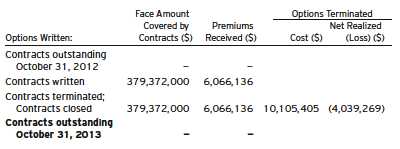
Forward Foreign Currency Exchange Contracts: The fund enters into forward contracts in order to hedge its exposure to changes in foreign currency exchange rates on its foreign portfolio holdings, to settle foreign currency transactions or as a part of its investment strategy. When executing forward contracts, the fund is obligated to buy or sell a foreign currency at a specified rate on a certain date in the future. With respect to sales of forward contracts, the fund incurs a loss if the value of the contract increases between the date the forward contract is opened and the date the forward contract is closed.The fund realizes a gain if the value of the contract decreases between those dates.With respect to purchases of forward contracts, the fund incurs a loss if the value of the contract decreases between the date the forward contract is opened and the date the forward contract is closed.The fund realizes
48
a gain if the value of the contract increases between those dates. Any realized or unrealized gains or losses which occurred during the period are reflected in the Statement of Operations. The fund is exposed to foreign currency risk as a result of changes in value of underlying financial instruments.The fund is also exposed to credit risk associated with counterparty nonperformance on these forward contracts, which is generally limited to the unrealized gain on each open contract.The following summarizes open forward contracts at October 31, 2013:
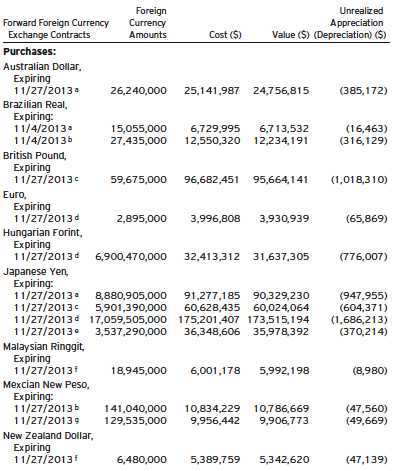
The Fund 49
NOTES TO FINANCIAL STATEMENTS (continued)
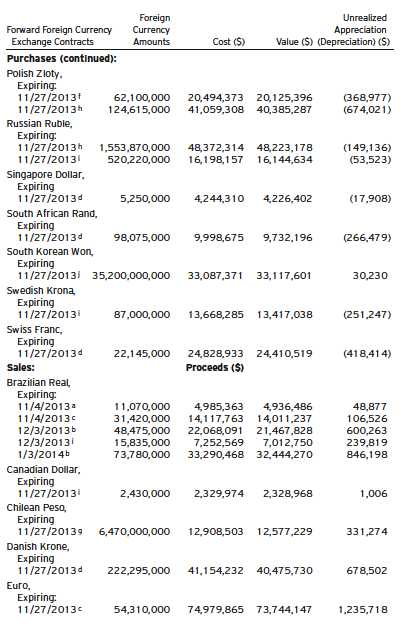
50
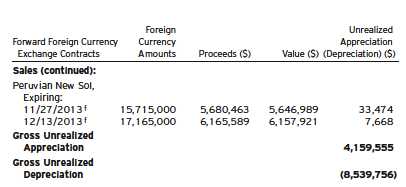
| |
| Counterparties: |
| a | Bank of America |
| b | Morgan Stanley Capital Services |
| c | Barclays Bank |
| d | Goldman Sachs International |
| e | Royal Bank of Scotland |
| f | Citigroup |
| g | JP Morgan Chase Bank |
| h | Credit Suisse |
| i | Deutsche Bank |
| j | Standard Chartered Bank |
Swap Transactions: The fund enters into swap agreements to exchange the interest rate on, or return generated by, one nominal instrument for the return generated by another nominal instrument. Swap agreements are privately negotiated in the over-the-counter (“OTC”) market or centrally cleared.The fund enters into these agreements to hedge certain market or interest rate risks, to manage the interest rate sensitivity (sometimes called duration) of fixed income securities, to provide a substitute for purchasing or selling particular securities or to increase potential returns.
For OTC swaps, the fund accrues for the interim payments on a daily basis, with the net amount recorded within unrealized appreciation (depreciation) on swap agreements in the Statement of Assets and Liabilities. Once the interim payments are settled in cash, the net
The Fund 51
NOTES TO FINANCIAL STATEMENTS (continued)
amount is recorded as a realized gain (loss) on swaps, in addition to realized gain (loss) recorded upon the termination of swap transactions in the Statement of Operations. Upfront payments made and/or received by the fund, are recorded as an asset and/or liability in the Statement of Assets and Liabilities and are recorded as a realized gain or loss ratably over the agreement’s term/event with the exception of forward starting interest rate swaps which are recorded as realized gains or losses on the termination date.
Upon entering into centrally cleared swap agreements, an initial margin deposit is required with a counterparty, which consists of cash or cash equivalents. The amount of these deposits is determined by the exchange on which the agreements is traded and is subject to change. The change in valuation of centrally cleared swaps is recorded as a receivable or payable for variation margin in the Statement of Assets and Liabilities. Payments received from (paid to) the counterparty, including upon termination, are recorded as realized gain (loss) in the Statement of Operations.
Fluctuations in the value of swap agreements are recorded for financial statement purposes as unrealized appreciation or depreciation on swap transactions.
Interest Rate Swaps: Interest rate swaps involve the exchange of commitments to pay and receive interest based on a notional principal amount. The fund may elect to pay a fixed rate and receive a floating rate, or receive a fixed rate and pay a floating rate on a notional principal amount. The net interest received or paid on interest rate swap agreements is included within realized gain (loss) on swap transactions in the Statement of Operations. Interest rate swap agreements are subject to general market risk, liquidity risk, counterparty risk and interest rate risk.
For OTC swaps, the fund’s maximum risk of loss from counterparty risk is the discounted value of the cash flows to be received from the counterparty over the agreement’s remaining life, to the extent that the amount is positive. This risk is mitigated by MNA between the fund and the counterparty and the posting of collateral by the coun-terparty to the fund to cover the fund’s exposure to the counterparty.
52
There is minimal counterparty risk to the fund with centrally cleared swaps since they are exchange traded, and the exchange guarantees these swaps against default. The following summarizes open interest rate swaps entered into by the fund at October 31, 2013:
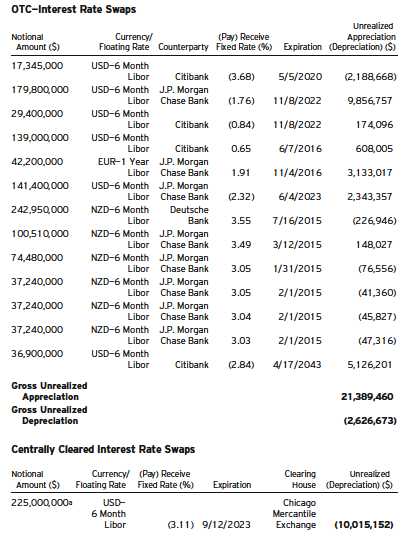
|
| Counterparty; |
| a Deutsche Bank |
The Fund 53
NOTES TO FINANCIAL STATEMENTS (continued)
Credit Default Swaps: Credit default swaps involve commitments to pay a fixed interest rate in exchange for payment if a credit event affecting a third party (the referenced company, obligation or index) occurs. Credit events may include a failure to pay interest or principal, bankruptcy, or restructuring.The fund enters into these agreements to manage its exposure to the market or certain sectors of the market, to reduce its risk exposure to defaults of corporate and sovereign issuers, or to create exposure to corporate or sovereign issuers to which it is not otherwise exposed. For those credit default swaps in which the fund is paying a fixed rate, the fund is buying credit protection on the instrument. In the event of a credit event, the fund would receive the full notional amount for the reference obligation. For those credit default swaps in which the fund is receiving a fixed rate, the fund is selling credit protection on the underlying instrument.The maximum payouts for these agreements are limited to the notional amount of each swap. Credit default swaps may involve greater risks than if the fund had invested in the reference obligation directly and are subject to general market risk, liquidity risk, counterparty risk and credit risk. This risk is mitigated by MNA between the fund and the counterparty and the posting of collateral by the counterparty to the fund to cover the fund’s exposure to the counterparty.
The maximum potential amount of future payments (undiscounted) that a fund as a seller of protection could be required to make under a credit default swap agreement would be an amount equal to the notional amount of the agreement which may exceed the amount of unrealized appreciation or depreciation reflected in the Statement of Assets and Liabilities. Notional amounts of all credit default swap agreements are disclosed in the following chart, which summarizes open credit default swaps on index issues entered into by the fund. These potential amounts would be partially offset by any recovery values of the respective referenced obligations, underlying securities comprising the referenced index, upfront payments received upon entering into the agreement, or net amounts received from the settlement of buy pro-
54
tection credit default swap agreements entered into by the fund for the same referenced entity or entities. The following summarizes open credit default swaps entered into by the fund at October 31, 2013:
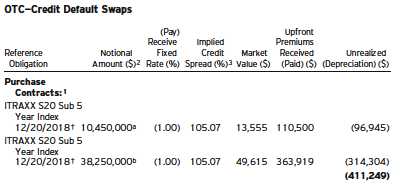
| |
| † | Expiration Date |
| Counterparties: |
| a | JP Morgan Chase Bank |
| b | Deutsche Bank |
| 1 | If the fund is a buyer of protection and a credit event occurs, as defined under the terms of the |
| | swap agreement, the fund will either (i) receive from the seller of protection an amount equal to the |
| | notional amount of the swap and deliver the reference obligation or (ii) receive a net settlement |
| | amount in the form of cash or securities equal to the notional amount of the swap less the recovery |
| | value of the reference obligation. |
| 2 | The maximum potential amount the fund could be required to pay as a seller of credit protection |
| | or receive as a buyer of credit protection if a credit event occurs as defined under the terms of the |
| | swap agreement. |
| 3 | Implied credit spreads, represented in absolute terms, utilized in determining the market value as of |
| | the period end serve as an indicator of the current status of the payment/performance risk and |
| | represent the likelihood of risk of default for the credit derivative.The credit spread of a particular |
| | referenced entity reflects the cost of buying/selling protection and may include upfront payments |
| | required to be made to enter into the agreement.Wider credit spreads represent a deterioration of |
| | the referenced entity's credit soundness and a greater likelihood of risk of default or other credit |
| | event occurring as defined under the terms of the agreement.A credit spread identified as |
| | “Defaulted” indicates a credit event has occurred for the referenced entity. |
GAAP requires disclosure for (i) the nature and terms of the credit derivative, reasons for entering into the credit derivative, the events or circumstances that would require the seller to perform under the credit derivative, and the current status of the payment/performance risk of the credit derivative, (ii) the maximum potential amount of future payments
The Fund 55
NOTES TO FINANCIAL STATEMENTS (continued)
(undiscounted) the seller could be required to make under the credit derivative, (iii) the fair value of the credit derivative, and (iv) the nature of any recourse provisions and assets held either as collateral or by third parties. All required disclosures have been made and are incorporated within the current period as part of the Notes to the Statement of Investments and disclosures within this Note.
The following tables show the fund’s exposure to different types of market risk as it relates to the Statement of Assets and Liabilities and the Statement of Operations, respectively.
Fair value of derivative instruments as of October 31, 2013 is shown below:

| |
| Statement of Assets and Liabilities location: |
| 1 | Includes cumulative appreciation (depreciation) on financial futures as reported in the Statement of |
| | Financial Futures, but only the unpaid variation margin is reported in the Statement of Assets |
| | and Liabilities. |
| 2 | Options purchased are included in Investments in securities—Unaffiliated issuers, at value. |
| 3 | Includes cumulative appreciation (depreciation) on swap agreements as reported in the swap tables |
| | in Note 4. Unrealized appreciation (depreciation) on OTC swap agreements and only unpaid |
| | variation on cleared swap agreements, is reported in the Statement and Liabilities. |
| 4 | Unrealized appreciation on forward foreign currency exchange contracts. |
| 5 | Unrealized depreciation on forward foreign currency exchange contracts. |
The effect of derivative instruments in the Statement of Operations during the period ended October 31, 2013 is shown below:
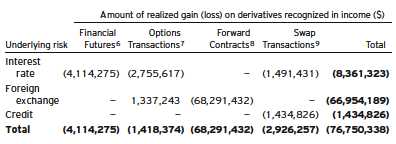
56
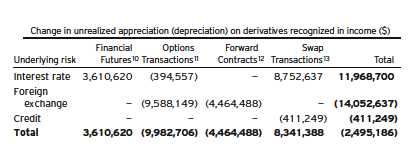
| |
| Statement of Operations location: |
| 6 | Net realized gain (loss) on financial futures. |
| 7 | Net realized gain (loss) on options transactions. |
| 8 | Net realized gain (loss) on forward foreign currency exchange contracts. |
| 9 | Net realized gain (loss) on swap transactions. |
| 10 Net unrealized appreciation (depreciation) on financial futures. |
| 11 Net unrealized appreciation (depreciation) on options transactions. |
| 12 Net unrealized appreciation (depreciation) on forward foreign currency exchange contracts. |
| 13 Net unrealized appreciation (depreciation) on swap transactions. |
The following summarizes the average market value of derivatives outstanding during the period ended October 31, 2013:

The following summarizes the average notional value of swap contracts outstanding during the period ended October 31, 2013:

At October 31, 2013, the cost of investments for federal income tax purposes was $1,579,340,205; accordingly, accumulated net unrealized appreciation on investments was $36,016,399, consisting of $62,536,253 gross unrealized appreciation and $26,519,854 gross unrealized depreciation.
The Fund 57
REPORT OF INDEPENDENT REGISTERED
PUBLIC ACCOUNTING FIRM
The Board of Trustees and Shareholders
The Dreyfus/Laurel Funds Trust
We have audited the accompanying statement of assets and liabilities of Dreyfus International Bond Fund (the “Fund”), a series of The Dreyfus/Laurel Funds Trust, including the statements of investments and financial futures, as of October 31, 2013, the related statement of operations for the year then ended, the statements of changes in net assets for each of the years in the two-year period then ended, and the financial highlights for each of the years or period in the five-year period then ended.These financial statements and financial highlights are the responsibility of the Fund’s management. Our responsibility is to express an opinion on these financial statements and financial highlights based on our audits.
We conducted our audits in accordance with the standards of the Public Company Accounting Oversight Board (United States).Those standards require that we plan and perform the audit to obtain reasonable assurance about whether the financial statements and financial highlights are free of material misstatement. An audit includes examining, on a test basis, evidence supporting the amounts and disclosures in the financial statements. Our procedures included confirmation of securities owned as of October 31, 2013, by correspondence with the custodian and brokers or by other appropriate auditing procedures.An audit also includes assessing the accounting principles used and significant estimates made by management, as well as evaluating the overall financial statement presentation. We believe that our audits provide a reasonable basis for our opinion.
In our opinion, the financial statements and financial highlights referred to above present fairly, in all material respects, the financial position of Dreyfus International Bond Fund as of October 31, 2013, the results of its operations for the year then ended, the changes in its net assets for each of the years in the two-year period then ended, and the financial highlights for each of the years or period in the five-year period then ended, in conformity with U.S. generally accepted accounting principles.

New York, New York
December 30, 2013
58
IMPORTANT TAX INFORMATION (Unaudited)
For federal tax purposes, the fund designates the maximum amount allowable but not less than 25.02% as interest-related dividends in accordance with Sections 871(k)(1) and 881(e) of the Internal Revenue Code. Also, the fund reports the maximum amount allowable but not less than $.2180 as a short-term capital gain dividend paid on December 27, 2012 in accordance with Sections 871(k)(2) and 881(e) of the Internal Revenue Code.
The Fund 59
BOARD MEMBERS INFORMATION (Unaudited)

60
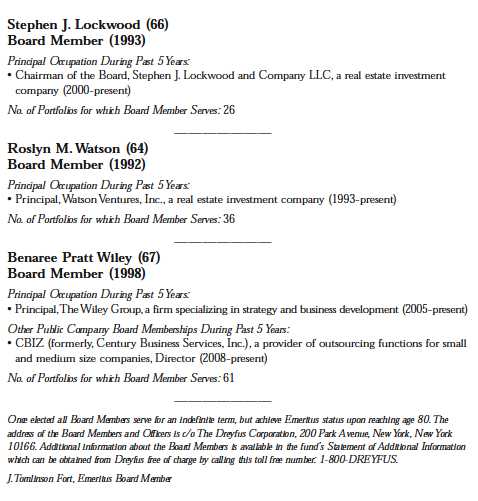
The Fund 61
OFFICERS OF THE FUND (Unaudited)
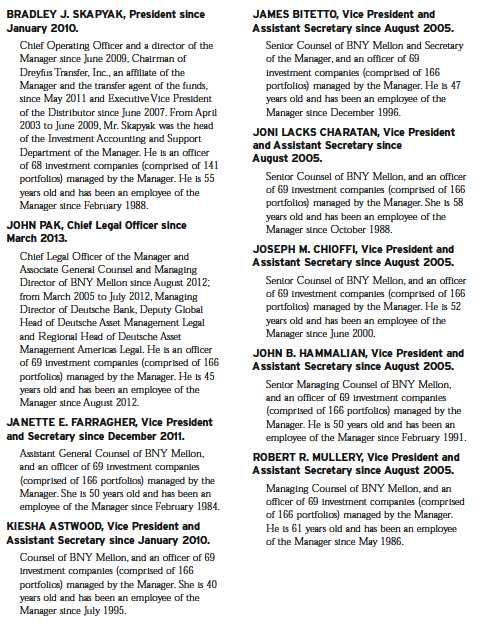
62
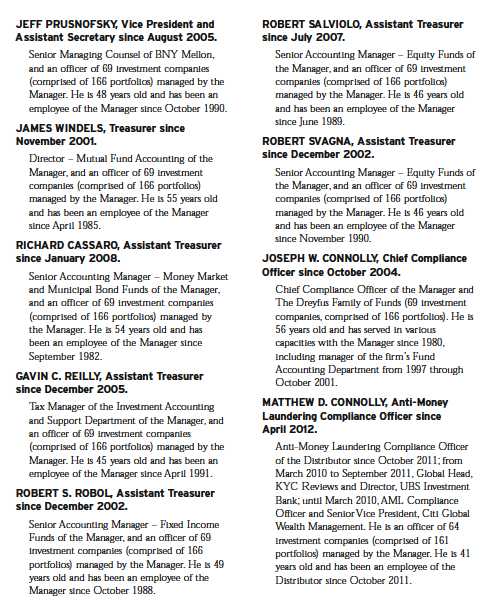
The Fund 63
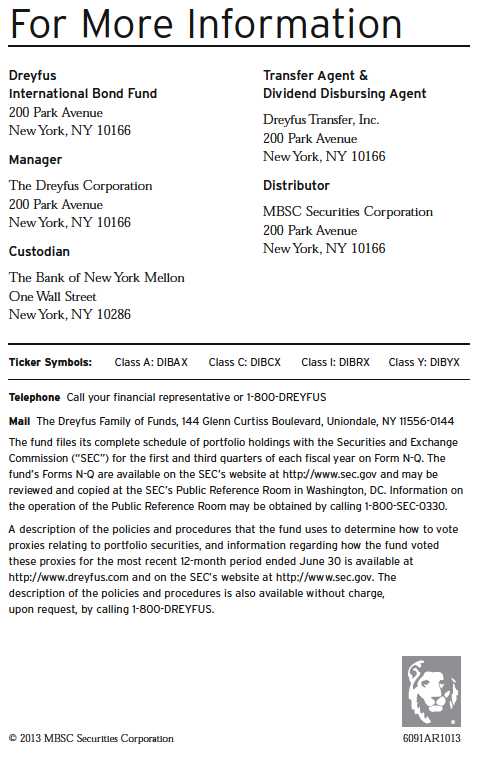
Item 2. Code of Ethics.
The Registrant has adopted a code of ethics that applies to the Registrant's principal executive officer, principal financial officer, principal accounting officer or controller, or persons performing similar functions. There have been no amendments to, or waivers in connection with, the Code of Ethics during the period covered by this Report.
Item 3. Audit Committee Financial Expert.
The Registrant's Board has determined that Joseph S. DiMartino a member of the Audit Committee of the Board, is an audit committee financial expert as defined by the Securities and Exchange Commission (the "SEC"). Mr. DiMartino is "independent" as defined by the SEC for purposes of audit committee financial expert determinations.
Item 4. Principal Accountant Fees and Services.
(a) Audit Fees. The aggregate fees billed for each of the last two fiscal years (the "Reporting Periods") for professional services rendered by the Registrant's principal accountant (the "Auditor") for the audit of the Registrant's annual financial statements or services that are normally provided by the Auditor in connection with the statutory and regulatory filings or engagements for the Reporting Periods, were $70,010 in 2012 and $71,240 in 2013.
(b) Audit-Related Fees. The aggregate fees billed in the Reporting Periods for assurance and related services by the Auditor that are reasonably related to the performance of the audit of the Registrant's financial statements and are not reported under paragraph (a) of this Item 4 were $8,780 in 2012 and $8,980 in 2013. These services consisted of one or more of the following: (i) agreed upon procedures related to compliance with Internal Revenue Code section 817(h), (ii) security counts required by Rule 17f-2 under the Investment Company Act of 1940, as amended, (iii) advisory services as to the accounting or disclosure treatment of Registrant transactions or events and (iv) advisory services to the accounting or disclosure treatment of the actual or potential impact to the Registrant of final or proposed rules, standards or interpretations by the Securities and Exchange Commission, the Financial Accounting Standards Boards or other regulatory or standard-setting bodies.
The aggregate fees billed in the Reporting Periods for non-audit assurance and related services by the Auditor to the Registrant's investment adviser (not including any sub-investment adviser whose role is primarily portfolio management and is subcontracted with or overseen by another investment adviser), and any entity controlling, controlled by or under common control with the investment adviser that provides ongoing services to the Registrant ("Service Affiliates"), that were reasonably related to the performance of the annual audit of the Service Affiliate, which required pre-approval by the Audit Committee were $0 in 2012 and $0 in 2013.
(c) Tax Fees. The aggregate fees billed in the Reporting Periods for professional services rendered by the Auditor for tax compliance, tax advice, and tax planning ("Tax Services") were $4,520 in 2011 and $4,620 in 2012. These services consisted of the review or preparation of U.S. federal, state, local and excise tax returns. The aggregate fees billed in the Reporting Periods for Tax Services by the Auditor to Service Affiliates, which required pre-approval by the Audit Committee were $4,620 in 2012 and $4,720 in 2013.
(d) All Other Fees. The aggregate fees billed in the Reporting Periods for products and services provided by the Auditor, other than the services reported in paragraphs (a) through (c) of this Item, were $0 in 2012 and $0 in 2013.
The aggregate fees billed in the Reporting Periods for Non-Audit Services by the Auditor to Service Affiliates, other than the services reported in paragraphs (b) through (c) of this Item, which required pre-approval by the Audit Committee, were $0 in 2012 and $0 in 2013.
(e)(1) Audit Committee Pre-Approval Policies and Procedures. The Registrant's Audit Committee has established policies and procedures (the "Policy") for pre-approval (within specified fee limits) of the Auditor's engagements for non-audit services to the Registrant and Service Affiliates without specific case-by-case consideration. The pre-approved services in the Policy can include pre-approved audit services, pre-approved audit-related services, pre-approved tax services and pre-approved all other services. Pre-approval considerations include whether the proposed services are compatible with maintaining the Auditor's independence. Pre-approvals pursuant to the Policy are considered annually.
(e)(2) Note: None of the services described in paragraphs (b) through (d) of this Item 4 were approved by the Audit Committee pursuant to paragraph (c)(7)(i)(C) of Rule 2-01 of Regulation S-X.
(f) None of the hours expended on the principal accountant's engagement to audit the registrant's financial statements for the most recent fiscal year were attributed to work performed by persons other than the principal account's full-time, permanent employees.
Non-Audit Fees. The aggregate non-audit fees billed by the Auditor for services rendered to the Registrant, and rendered to Service Affiliates, for the Reporting Periods were $11,571,150 in 2012 and $13,945,381 in 2013.
Auditor Independence. The Registrant's Audit Committee has considered whether the provision of non-audit services that were rendered to Service Affiliates, which were not pre-approved (not requiring pre-approval), is compatible with maintaining the Auditor's independence.
Item 5. Audit Committee of Listed Registrants.
Not applicable.
Item 6. Investments.
(a) Not applicable.
Item 7. Disclosure of Proxy Voting Policies and Procedures for Closed-End Management Investment Companies.
Not applicable.
Item 8. Portfolio Managers of Closed-End Management Investment Companies.
Not applicable.
Item 9. Purchases of Equity Securities by Closed-End Management Investment Companies and Affiliated Purchasers.
Not applicable.
Item 10. Submission of Matters to a Vote of Security Holders.
There have been no material changes to the procedures applicable to Item 10.
Item 11. Controls and Procedures.
(a) The Registrant's principal executive and principal financial officers have concluded, based on their evaluation of the Registrant's disclosure controls and procedures as of a date within 90 days of the filing date of this report, that the Registrant's disclosure controls and procedures are reasonably designed to ensure that information required to be disclosed by the Registrant on Form N-CSR is recorded, processed, summarized and reported within the required time periods and that information required to be disclosed by the Registrant in the reports that it files or submits on Form N-CSR is accumulated and communicated to the Registrant's management, including its principal executive and principal financial officers, as appropriate to allow timely decisions regarding required disclosure.
(b) There were no changes to the Registrant's internal control over financial reporting that occurred during the second fiscal quarter of the period covered by this report that have materially affected, or are reasonably likely to materially affect, the Registrant's internal control over financial reporting.
Item 12. Exhibits.
(a)(1) Code of ethics referred to in Item 2.
(a)(2) Certifications of principal executive and principal financial officers as required by Rule 30a-2(a) under the Investment Company Act of 1940.
(a)(3) Not applicable.
(b) Certification of principal executive and principal financial officers as required by Rule 30a-2(b) under the Investment Company Act of 1940.
SIGNATURES
Pursuant to the requirements of the Securities Exchange Act of 1934 and the Investment Company Act of 1940, the Registrant has duly caused this Report to be signed on its behalf by the undersigned, thereunto duly authorized.
The Dreyfus/Laurel Funds Trust
By: /s/ Bradley J. Skapyak |
Bradley J. Skapyak President |
Date: | December 18, 2013 |
|
Pursuant to the requirements of the Securities Exchange Act of 1934 and the Investment Company Act of 1940, this Report has been signed below by the following persons on behalf of the Registrant and in the capacities and on the dates indicated. |
|
By: /s/ Bradley J. Skapyak |
Bradley J. Skapyak President |
Date: | December 18, 2013 |
|
By: /s/ James Windels |
James Windels Treasurer |
Date: | December 18, 2013 |
|
EXHIBIT INDEX
(a)(1) Code of ethics referred to in Item 2.
(a)(2) Certifications of principal executive and principal financial officers as required by Rule 30a-2(a) under the Investment Company Act of 1940. (EX-99.CERT)
(b) Certification of principal executive and principal financial officers as required by Rule 30a-2(b) under the Investment Company Act of 1940. (EX-99.906CERT)































